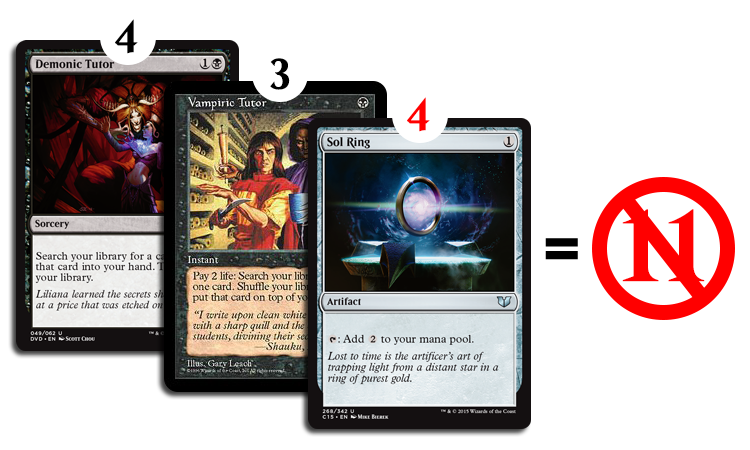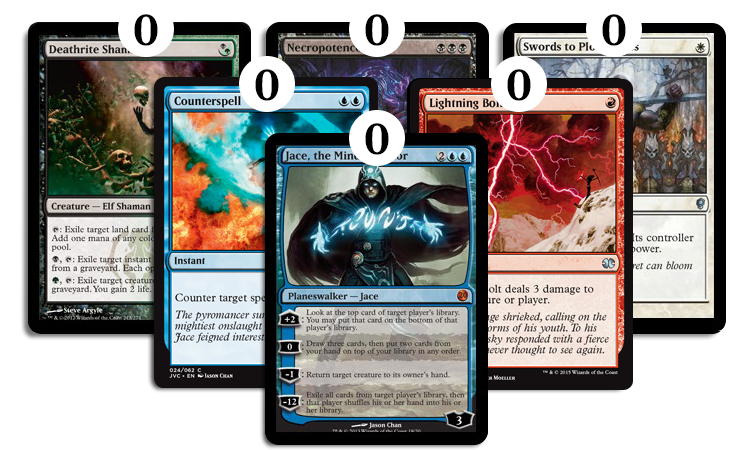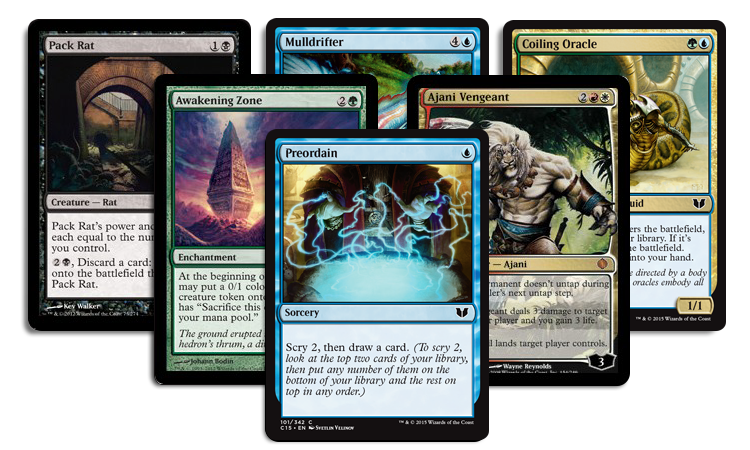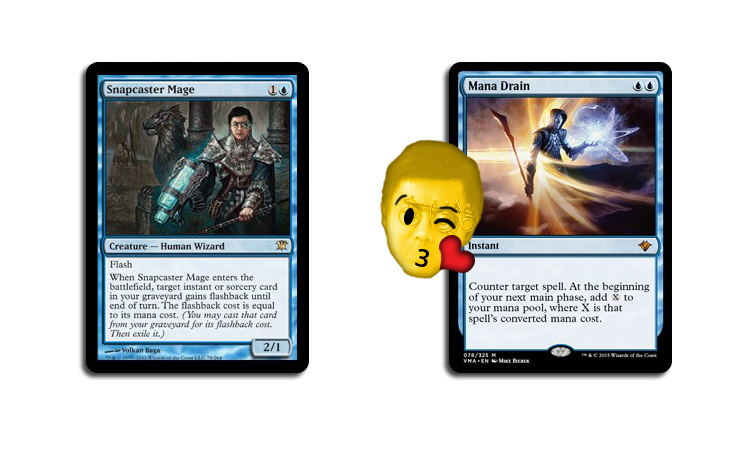"Ach! Hans, Run!"
That was the name of one of my first Magic decks. That one was built around the three copies of Lhurgoyf I owned. I had another one that tried to make a ton of Snake and Squirrel tokens using Ashnod's Altar, Snake Basket, and Liege of the Hollows. I can't remember what I named that monstrosity.
Still, I look back on these crusty cardboard deck boxes covered in marker ink with a feeling of great nostalgia. I remember feeling like I had my deck. My Magic deck, and that's what Magic was to me back then.
Nowadays I'm more interested in the subtle nuance of Limited, or the latest tech for Standard and Modern. I approach the game completely differently than I did back then.
But you know what I do miss? Having my Magic deck. There is something about the simplicity of just having your deck, and I miss it.
I've got that experience back now, though. I've got my Magic deck again. With Eternal Masters previews starting next week, I thought that today I would introduce you to the most fun Constructed format I've ever played: Canadian Highlander.
Let's get a few facts out of the way right off the bat:
- Canadian Highlander isn't specific to Canada (specifically Victoria, British Columbia). That's simply where it was invented by fans (sixteen years ago) and where it continues to flourish.
- It's a singleton format, which means that outside of basic lands, you can only play one copy of each card in your deck.
- You play with a minimum of 100 cards.
- You play with 20 life, and you duel one-on-one only. No multiplayer here.
- There are no sideboards.
- There are no commanders or any other color restrictions.
- It isn't an official Wizards format. It's a fan-made format that maintains its own rules and lists.
Canadian Highlander uses the Vintage banned list. You can find that list here.
The first thing that may come to your mind when you think of a Vintage banned and restricted list is that Vintage has the most powerful cards available in Magic. They don't even ban cards for power-level reasons in Vintage! And you would be correct.
The next thing you may be thinking is that if everyone gets to play with all of these super powerful cards from Magic's beginnings, then the format must be pretty degenerate. Combos, turn-one kills, that kind of thing.
While your instincts are correct, it doesn't play out that way for two main reasons:
The first is simple; we are talking about 100-card (typically, although you can use more if you'd like) singleton decks here. It's pretty hard to set up consistent combos or turn-one kills when you have to go that deep into the card pool. The nature of big singleton decks leads to games that don't resemble one another when played out (which is great).
The second is the most important and defining thing about Canadian Highlander, and it's called the points list.
The points list is an ingenious way to manage a format like this. It's pretty simple, too. The points list gives a point value to certain high-power-level cards, and you get a certain number of points (10 per 100 cards in your deck) to "spend" per deck.
For example, the first place your brewer brain may have gone when I mentioned setting up combos in a 100-card singleton deck was "tutor" effects—cards that let you search your library for specific cards and put them in your hand.
The best tutor ever printed is called Demonic Tutor.
Demonic Tutor will cost you 4 of your 10 points. Maybe you'd like a Vampiric Tutor as well? That's 3 points. Throw in a Sol Ring for fast mana (4 points), and you're at 11, over the limit of 10 total points.

You'll have to trim one of these cards and replace it with something a little less potent in order to keep your points at 10 or fewer.
Remember: not every card has points assigned to it. Only the most insanely powerful cards get points.

As an example, Jace, the Mind Sculptor doesn't have any points assigned to it. Counterspell (yes, Counterspell Counterspell) is 0 points as well. Same with Lightning Bolt, Deathrite Shaman, Necropotence, Swords to Plowshares, and most every other card ever printed.
The kinds of card that cost points fall into three broad categories:
Tutors/Search Effects
Fast Mana
Ridiculously Powerful or Broken Cards
Basically everything on the points list falls into one of these categories. There are usually between 40 and 50 cards on the points list at any given time.
You can check out the current points list here.
The points list does a great job of managing all the powerful things you could do in a format like this while still allowing you to pick an angle and go for it with some really cool, powerful cards.
You may be wondering what it's like to actually play the format. Is it casual? Competitive? How long do the games last? Why do you like this format so much? Which kinds of decks are the best?
Let's get into all of these questions now.
First, it's played in a competitive way. You are trying to get your opponent dead, and there are no two ways about it. Sometimes in multiplayer formats there are different motivations at play, but in Canadian Highlander, it's just regular Magic where you are duking it out against your opponent.
The games last a variable amount of time, but I would say they are roughly in line with a game of Modern.
As far as why I love the format and how to describe it to someone who hasn't played it yet, I decided to go right to the source—to the players who invented and cultivated the format.
I asked them how they would describe it.
David Brunsdon had a short but accurately sweet summation when he said, "It's where competitive players go to have fun."
I thought Nelson Salahub's description was really interesting too: "Canadian Highlander is Cube Constructed. It allows you to walk down memory lane and play your favorite old cards and still compete."
Cube Constructed. That's exactly how it feels when you play it. If you've ever had the chance to do a Cube Draft before, you'll know that you get to play with many of the most powerful and sweet spells from Magic's history. Usually you end up building some kind of cool archetype and taking it to battle. In Canadian Highlander, you get to fully build out one of these decks and fine-tune it to your heart's desire. It's awesome.
And this really hits on something that I love about the format. When I think back to cards that I have loved from the past, there are many. Some I drafted a bunch, or built decks around, or played in Standard when they were legal.

Cards like Preordain, Jace, the Mind Sculptor, Awakening Zone, Ajani Vengeant, Pack Rat, Mulldrifter, and Coiling Oracle are cards I've loved for a long time. But where can I play them now?
Many aren't powerful enough for Modern or Legacy, and they haven't been Standard legal in years. A lot of people find solace in Commander, as it has a similar structure and creates a similar space for you to have "your deck" where you get to play with your favorite cards from the past.
The problem I faced is that many of these cards aren't particularly good in Commander, as it's focused a bit more on the expensive spells rather than the cheap efficient spells that I love. Playing planeswalkers is a good way to get a target on your back in Commander.
If I want to play Preordain, I have to go all the way back to Legacy or Vintage, for example.
I love that I've found a home for all of these cards to live together in harmony. That's right, I get to mix all of these old favorites and new additions together in one deck! Let me tell you, Snapcaster Mage targeting Mana Drain is pretty nice. Ten out of ten, would target again.

Tyler Woolley described the format like this: "A format where the metagame never stops evolving, so the brewing never stops."
And this really is at the heart of the format. It's an absolute brewer's paradise.
The format doesn't ever rotate, so you know that after getting your "singleton playset" (one copy of a card), you're good to go forever.
While the barrier to entry isn't low (I would say it's comparable to a Commander deck), it's nice to know that the worst thing that can happen is that your cards shift a little in points (they do update the points list a few times a year).
But nothing ever gets banned, and nothing ever rotates. This is fertile ground for some pretty savage brewing!
Let's take a look at a few decklists to give you an idea of which strategies have traditionally been powerful in the format. Ben Wheeler provided me with these lists as a sort of metagame snapshot.
You like green ramp decks? Take a look at this "CradleHoof" deck that has been tearing up the tournaments in Victoria for a while now:
CradleHoof


a:83:{i:0;O:8:"stdClass":3:{s:9:"card_meta";O:8:"stdClass":2:{s:5:"title";s:19:"Craterhoof Behemoth";s:22:"field_card_image_front";a:0:{}}s:4:"type";s:8:"creature";s:10:"deck_count";s:1:"1";}i:1;O:8:"stdClass":3:{s:9:"card_meta";O:8:"stdClass":2:{s:5:"title";s:9:"Arbor Elf";s:22:"field_card_image_front";a:0:{}}s:4:"type";s:8:"creature";s:10:"deck_count";s:1:"1";}i:2;O:8:"stdClass":3:{s:9:"card_meta";O:8:"stdClass":2:{s:5:"title";s:16:"Avacyn's Pilgrim";s:22:"field_card_image_front";a:0:{}}s:4:"type";s:8:"creature";s:10:"deck_count";s:1:"1";}i:3;O:8:"stdClass":3:{s:9:"card_meta";O:8:"stdClass":2:{s:5:"title";s:5:"Bayou";s:22:"field_card_image_front";a:0:{}}s:4:"type";s:4:"land";s:10:"deck_count";s:1:"1";}i:4;O:8:"stdClass":3:{s:9:"card_meta";O:8:"stdClass":2:{s:5:"title";s:17:"Birds of Paradise";s:22:"field_card_image_front";a:0:{}}s:4:"type";s:8:"creature";s:10:"deck_count";s:1:"1";}i:5;O:8:"stdClass":3:{s:9:"card_meta";O:8:"stdClass":2:{s:5:"title";s:17:"Bloodstained Mire";s:22:"field_card_image_front";a:0:{}}s:4:"type";s:4:"land";s:10:"deck_count";s:1:"1";}i:6;O:8:"stdClass":3:{s:9:"card_meta";O:8:"stdClass":2:{s:5:"title";s:12:"Boreal Druid";s:22:"field_card_image_front";a:0:{}}s:4:"type";s:8:"creature";s:10:"deck_count";s:1:"1";}i:7;O:8:"stdClass":3:{s:9:"card_meta";O:8:"stdClass":2:{s:5:"title";s:16:"Chord of Calling";s:22:"field_card_image_front";a:0:{}}s:4:"type";s:7:"instant";s:10:"deck_count";s:1:"1";}i:8;O:8:"stdClass":3:{s:9:"card_meta";O:8:"stdClass":2:{s:5:"title";s:13:"Crop Rotation";s:22:"field_card_image_front";a:0:{}}s:4:"type";s:7:"instant";s:10:"deck_count";s:1:"1";}i:9;O:8:"stdClass":3:{s:9:"card_meta";O:8:"stdClass":2:{s:5:"title";s:11:"Dark Depths";s:22:"field_card_image_front";a:0:{}}s:4:"type";s:4:"land";s:10:"deck_count";s:1:"1";}i:10;O:8:"stdClass":3:{s:9:"card_meta";O:8:"stdClass":2:{s:5:"title";s:16:"Deathrite Shaman";s:22:"field_card_image_front";a:0:{}}s:4:"type";s:8:"creature";s:10:"deck_count";s:1:"1";}i:11;O:8:"stdClass":3:{s:9:"card_meta";O:8:"stdClass":2:{s:5:"title";s:13:"Devoted Druid";s:22:"field_card_image_front";a:0:{}}s:4:"type";s:8:"creature";s:10:"deck_count";s:1:"1";}i:12;O:8:"stdClass":3:{s:9:"card_meta";O:8:"stdClass":2:{s:5:"title";s:10:"Domri Rade";s:22:"field_card_image_front";a:0:{}}s:4:"type";s:12:"planeswalker";s:10:"deck_count";s:1:"1";}i:13;O:8:"stdClass":3:{s:9:"card_meta";O:8:"stdClass":2:{s:5:"title";s:17:"Dragonlord Atarka";s:22:"field_card_image_front";a:0:{}}s:4:"type";s:8:"creature";s:10:"deck_count";s:1:"1";}i:14;O:8:"stdClass":3:{s:9:"card_meta";O:8:"stdClass":2:{s:5:"title";s:11:"Dryad Arbor";s:22:"field_card_image_front";a:0:{}}s:4:"type";s:4:"land";s:10:"deck_count";s:1:"1";}i:15;O:8:"stdClass":3:{s:9:"card_meta";O:8:"stdClass":2:{s:5:"title";s:20:"Elves of Deep Shadow";s:22:"field_card_image_front";a:0:{}}s:4:"type";s:8:"creature";s:10:"deck_count";s:1:"1";}i:16;O:8:"stdClass":3:{s:9:"card_meta";O:8:"stdClass":2:{s:5:"title";s:16:"Elvish Archdruid";s:22:"field_card_image_front";a:0:{}}s:4:"type";s:8:"creature";s:10:"deck_count";s:1:"1";}i:17;O:8:"stdClass":3:{s:9:"card_meta";O:8:"stdClass":2:{s:5:"title";s:13:"Elvish Mystic";s:22:"field_card_image_front";a:0:{}}s:4:"type";s:8:"creature";s:10:"deck_count";s:1:"1";}i:18;O:8:"stdClass":3:{s:9:"card_meta";O:8:"stdClass":2:{s:5:"title";s:16:"Elvish Visionary";s:22:"field_card_image_front";a:0:{}}s:4:"type";s:8:"creature";s:10:"deck_count";s:1:"1";}i:19;O:8:"stdClass":3:{s:9:"card_meta";O:8:"stdClass":2:{s:5:"title";s:15:"Eternal Witness";s:22:"field_card_image_front";a:0:{}}s:4:"type";s:8:"creature";s:10:"deck_count";s:1:"1";}i:20;O:8:"stdClass":3:{s:9:"card_meta";O:8:"stdClass":2:{s:5:"title";s:12:"Fauna Shaman";s:22:"field_card_image_front";a:0:{}}s:4:"type";s:8:"creature";s:10:"deck_count";s:1:"1";}i:21;O:8:"stdClass":3:{s:9:"card_meta";O:8:"stdClass":2:{s:5:"title";s:13:"Fierce Empath";s:22:"field_card_image_front";a:0:{}}s:4:"type";s:8:"creature";s:10:"deck_count";s:1:"1";}i:22;O:8:"stdClass":3:{s:9:"card_meta";O:8:"stdClass":2:{s:5:"title";s:6:"Forest";s:22:"field_card_image_front";a:0:{}}s:4:"type";s:4:"land";s:10:"deck_count";s:2:"18";}i:23;O:8:"stdClass":3:{s:9:"card_meta";O:8:"stdClass":2:{s:5:"title";s:14:"Fyndhorn Elder";s:22:"field_card_image_front";a:0:{}}s:4:"type";s:8:"creature";s:10:"deck_count";s:1:"1";}i:24;O:8:"stdClass":3:{s:9:"card_meta";O:8:"stdClass":2:{s:5:"title";s:14:"Fyndhorn Elves";s:22:"field_card_image_front";a:0:{}}s:4:"type";s:8:"creature";s:10:"deck_count";s:1:"1";}i:25;O:8:"stdClass":3:{s:9:"card_meta";O:8:"stdClass":2:{s:5:"title";s:13:"Gaea's Cradle";s:22:"field_card_image_front";a:0:{}}s:4:"type";s:4:"land";s:10:"deck_count";s:1:"1";}i:26;O:8:"stdClass":3:{s:9:"card_meta";O:8:"stdClass":2:{s:5:"title";s:17:"Garruk Relentless";s:22:"field_card_image_front";a:0:{}}s:4:"type";s:12:"planeswalker";s:10:"deck_count";s:1:"1";}i:27;O:8:"stdClass":3:{s:9:"card_meta";O:8:"stdClass":2:{s:5:"title";s:18:"Garruk Wildspeaker";s:22:"field_card_image_front";a:0:{}}s:4:"type";s:12:"planeswalker";s:10:"deck_count";s:1:"1";}i:28;O:8:"stdClass":3:{s:9:"card_meta";O:8:"stdClass":2:{s:5:"title";s:24:"Garruk, Caller of Beasts";s:22:"field_card_image_front";a:0:{}}s:4:"type";s:12:"planeswalker";s:10:"deck_count";s:1:"1";}i:29;O:8:"stdClass":3:{s:9:"card_meta";O:8:"stdClass":2:{s:5:"title";s:21:"Garruk, Primal Hunter";s:22:"field_card_image_front";a:0:{}}s:4:"type";s:12:"planeswalker";s:10:"deck_count";s:1:"1";}i:30;O:8:"stdClass":3:{s:9:"card_meta";O:8:"stdClass":2:{s:5:"title";s:18:"Green Sun's Zenith";s:22:"field_card_image_front";a:0:{}}s:4:"type";s:7:"sorcery";s:10:"deck_count";s:1:"1";}i:31;O:8:"stdClass":3:{s:9:"card_meta";O:8:"stdClass":2:{s:5:"title";s:17:"Greenweaver Druid";s:22:"field_card_image_front";a:0:{}}s:4:"type";s:8:"creature";s:10:"deck_count";s:1:"1";}i:32;O:8:"stdClass":3:{s:9:"card_meta";O:8:"stdClass":2:{s:5:"title";s:24:"Grove of the Burnwillows";s:22:"field_card_image_front";a:0:{}}s:4:"type";s:4:"land";s:10:"deck_count";s:1:"1";}i:33;O:8:"stdClass":3:{s:9:"card_meta";O:8:"stdClass":2:{s:5:"title";s:9:"Harmonize";s:22:"field_card_image_front";a:0:{}}s:4:"type";s:7:"sorcery";s:10:"deck_count";s:1:"1";}i:34;O:8:"stdClass":3:{s:9:"card_meta";O:8:"stdClass":2:{s:5:"title";s:12:"Hornet Queen";s:22:"field_card_image_front";a:0:{}}s:4:"type";s:8:"creature";s:10:"deck_count";s:1:"1";}i:35;O:8:"stdClass":3:{s:9:"card_meta";O:8:"stdClass":2:{s:5:"title";s:18:"Joraga Treespeaker";s:22:"field_card_image_front";a:0:{}}s:4:"type";s:8:"creature";s:10:"deck_count";s:1:"1";}i:36;O:8:"stdClass":3:{s:9:"card_meta";O:8:"stdClass":2:{s:5:"title";s:16:"Karplusan Forest";s:22:"field_card_image_front";a:0:{}}s:4:"type";s:4:"land";s:10:"deck_count";s:1:"1";}i:37;O:8:"stdClass":3:{s:9:"card_meta";O:8:"stdClass":2:{s:5:"title";s:15:"Kessig Wolf Run";s:22:"field_card_image_front";a:0:{}}s:4:"type";s:4:"land";s:10:"deck_count";s:1:"1";}i:38;O:8:"stdClass":3:{s:9:"card_meta";O:8:"stdClass":2:{s:5:"title";s:18:"Kozilek's Predator";s:22:"field_card_image_front";a:0:{}}s:4:"type";s:8:"creature";s:10:"deck_count";s:1:"1";}i:39;O:8:"stdClass":3:{s:9:"card_meta";O:8:"stdClass":2:{s:5:"title";s:14:"Llanowar Elves";s:22:"field_card_image_front";a:0:{}}s:4:"type";s:8:"creature";s:10:"deck_count";s:1:"1";}i:40;O:8:"stdClass":3:{s:9:"card_meta";O:8:"stdClass":2:{s:5:"title";s:10:"Mana Vault";s:22:"field_card_image_front";a:0:{}}s:4:"type";s:8:"artifact";s:10:"deck_count";s:1:"1";}i:41;O:8:"stdClass":3:{s:9:"card_meta";O:8:"stdClass":2:{s:5:"title";s:16:"Misty Rainforest";s:22:"field_card_image_front";a:0:{}}s:4:"type";s:4:"land";s:10:"deck_count";s:1:"1";}i:42;O:8:"stdClass":3:{s:9:"card_meta";O:8:"stdClass":2:{s:5:"title";s:17:"Multani's Acolyte";s:22:"field_card_image_front";a:0:{}}s:4:"type";s:8:"creature";s:10:"deck_count";s:1:"1";}i:43;O:8:"stdClass":3:{s:9:"card_meta";O:8:"stdClass":2:{s:5:"title";s:13:"Nantuko Elder";s:22:"field_card_image_front";a:0:{}}s:4:"type";s:8:"creature";s:10:"deck_count";s:1:"1";}i:44;O:8:"stdClass":3:{s:9:"card_meta";O:8:"stdClass":2:{s:5:"title";s:13:"Natural Order";s:22:"field_card_image_front";a:0:{}}s:4:"type";s:7:"sorcery";s:10:"deck_count";s:1:"1";}i:45;O:8:"stdClass":3:{s:9:"card_meta";O:8:"stdClass":2:{s:5:"title";s:12:"Nest Invader";s:22:"field_card_image_front";a:0:{}}s:4:"type";s:8:"creature";s:10:"deck_count";s:1:"1";}i:46;O:8:"stdClass":3:{s:9:"card_meta";O:8:"stdClass":2:{s:5:"title";s:14:"Noble Hierarch";s:22:"field_card_image_front";a:0:{}}s:4:"type";s:8:"creature";s:10:"deck_count";s:1:"1";}i:47;O:8:"stdClass":3:{s:9:"card_meta";O:8:"stdClass":2:{s:5:"title";s:22:"Nykthos, Shrine to Nyx";s:22:"field_card_image_front";a:0:{}}s:4:"type";s:4:"land";s:10:"deck_count";s:1:"1";}i:48;O:8:"stdClass":3:{s:9:"card_meta";O:8:"stdClass":2:{s:5:"title";s:20:"Overgrown Battlement";s:22:"field_card_image_front";a:0:{}}s:4:"type";s:8:"creature";s:10:"deck_count";s:1:"1";}i:49;O:8:"stdClass":3:{s:9:"card_meta";O:8:"stdClass":2:{s:5:"title";s:17:"Priest of Titania";s:22:"field_card_image_front";a:0:{}}s:4:"type";s:8:"creature";s:10:"deck_count";s:1:"1";}i:50;O:8:"stdClass":3:{s:9:"card_meta";O:8:"stdClass":2:{s:5:"title";s:14:"Primal Command";s:22:"field_card_image_front";a:0:{}}s:4:"type";s:7:"sorcery";s:10:"deck_count";s:1:"1";}i:51;O:8:"stdClass":3:{s:9:"card_meta";O:8:"stdClass":2:{s:5:"title";s:14:"Primeval Titan";s:22:"field_card_image_front";a:0:{}}s:4:"type";s:8:"creature";s:10:"deck_count";s:1:"1";}i:52;O:8:"stdClass":3:{s:9:"card_meta";O:8:"stdClass":2:{s:5:"title";s:14:"Quirion Ranger";s:22:"field_card_image_front";a:0:{}}s:4:"type";s:8:"creature";s:10:"deck_count";s:1:"1";}i:53;O:8:"stdClass":3:{s:9:"card_meta";O:8:"stdClass":2:{s:5:"title";s:17:"Rattleclaw Mystic";s:22:"field_card_image_front";a:0:{}}s:4:"type";s:8:"creature";s:10:"deck_count";s:1:"1";}i:54;O:8:"stdClass":3:{s:9:"card_meta";O:8:"stdClass":2:{s:5:"title";s:16:"Reclamation Sage";s:22:"field_card_image_front";a:0:{}}s:4:"type";s:8:"creature";s:10:"deck_count";s:1:"1";}i:55;O:8:"stdClass":3:{s:9:"card_meta";O:8:"stdClass":2:{s:5:"title";s:27:"Rofellos, Llanowar Emissary";s:22:"field_card_image_front";a:0:{}}s:4:"type";s:8:"creature";s:10:"deck_count";s:1:"1";}i:56;O:8:"stdClass":3:{s:9:"card_meta";O:8:"stdClass":2:{s:5:"title";s:23:"Ruric Thar, the Unbowed";s:22:"field_card_image_front";a:0:{}}s:4:"type";s:8:"creature";s:10:"deck_count";s:1:"1";}i:57;O:8:"stdClass":3:{s:9:"card_meta";O:8:"stdClass":2:{s:5:"title";s:15:"Scavenging Ooze";s:22:"field_card_image_front";a:0:{}}s:4:"type";s:8:"creature";s:10:"deck_count";s:1:"1";}i:58;O:8:"stdClass":3:{s:9:"card_meta";O:8:"stdClass":2:{s:5:"title";s:12:"Scryb Ranger";s:22:"field_card_image_front";a:0:{}}s:4:"type";s:8:"creature";s:10:"deck_count";s:1:"1";}i:59;O:8:"stdClass":3:{s:9:"card_meta";O:8:"stdClass":2:{s:5:"title";s:8:"Sol Ring";s:22:"field_card_image_front";a:0:{}}s:4:"type";s:8:"artifact";s:10:"deck_count";s:1:"1";}i:60;O:8:"stdClass":3:{s:9:"card_meta";O:8:"stdClass":2:{s:5:"title";s:15:"Stomping Ground";s:22:"field_card_image_front";a:0:{}}s:4:"type";s:4:"land";s:10:"deck_count";s:1:"1";}i:61;O:8:"stdClass":3:{s:9:"card_meta";O:8:"stdClass":2:{s:5:"title";s:15:"Sylvan Caryatid";s:22:"field_card_image_front";a:0:{}}s:4:"type";s:8:"creature";s:10:"deck_count";s:1:"1";}i:62;O:8:"stdClass":3:{s:9:"card_meta";O:8:"stdClass":2:{s:5:"title";s:14:"Sylvan Library";s:22:"field_card_image_front";a:0:{}}s:4:"type";s:11:"enchantment";s:10:"deck_count";s:1:"1";}i:63;O:8:"stdClass":3:{s:9:"card_meta";O:8:"stdClass":2:{s:5:"title";s:14:"Sylvan Scrying";s:22:"field_card_image_front";a:0:{}}s:4:"type";s:7:"sorcery";s:10:"deck_count";s:1:"1";}i:64;O:8:"stdClass":3:{s:9:"card_meta";O:8:"stdClass":2:{s:5:"title";s:5:"Taiga";s:22:"field_card_image_front";a:0:{}}s:4:"type";s:4:"land";s:10:"deck_count";s:1:"1";}i:65;O:8:"stdClass":3:{s:9:"card_meta";O:8:"stdClass":2:{s:5:"title";s:10:"Terastodon";s:22:"field_card_image_front";a:0:{}}s:4:"type";s:8:"creature";s:10:"deck_count";s:1:"1";}i:66;O:8:"stdClass":3:{s:9:"card_meta";O:8:"stdClass":2:{s:5:"title";s:16:"Thespian's Stage";s:22:"field_card_image_front";a:0:{}}s:4:"type";s:4:"land";s:10:"deck_count";s:1:"1";}i:67;O:8:"stdClass":3:{s:9:"card_meta";O:8:"stdClass":2:{s:5:"title";s:14:"Tooth and Nail";s:22:"field_card_image_front";a:0:{}}s:4:"type";s:7:"sorcery";s:10:"deck_count";s:1:"1";}i:68;O:8:"stdClass":3:{s:9:"card_meta";O:8:"stdClass":2:{s:5:"title";s:15:"Ulvenwald Hydra";s:22:"field_card_image_front";a:0:{}}s:4:"type";s:8:"creature";s:10:"deck_count";s:1:"1";}i:69;O:8:"stdClass":3:{s:9:"card_meta";O:8:"stdClass":2:{s:5:"title";s:13:"Utopia Sprawl";s:22:"field_card_image_front";a:0:{}}s:4:"type";s:11:"enchantment";s:10:"deck_count";s:1:"1";}i:70;O:8:"stdClass":3:{s:9:"card_meta";O:8:"stdClass":2:{s:5:"title";s:17:"Verdant Catacombs";s:22:"field_card_image_front";a:0:{}}s:4:"type";s:4:"land";s:10:"deck_count";s:1:"1";}i:71;O:8:"stdClass":3:{s:9:"card_meta";O:8:"stdClass":2:{s:5:"title";s:12:"Vine Trellis";s:22:"field_card_image_front";a:0:{}}s:4:"type";s:8:"creature";s:10:"deck_count";s:1:"1";}i:72;O:8:"stdClass":3:{s:9:"card_meta";O:8:"stdClass":2:{s:5:"title";s:14:"Voyaging Satyr";s:22:"field_card_image_front";a:0:{}}s:4:"type";s:8:"creature";s:10:"deck_count";s:1:"1";}i:73;O:8:"stdClass":3:{s:9:"card_meta";O:8:"stdClass":2:{s:5:"title";s:16:"Wall of Blossoms";s:22:"field_card_image_front";a:0:{}}s:4:"type";s:8:"creature";s:10:"deck_count";s:1:"1";}i:74;O:8:"stdClass":3:{s:9:"card_meta";O:8:"stdClass":2:{s:5:"title";s:13:"Wall of Roots";s:22:"field_card_image_front";a:0:{}}s:4:"type";s:8:"creature";s:10:"deck_count";s:1:"1";}i:75;O:8:"stdClass":3:{s:9:"card_meta";O:8:"stdClass":2:{s:5:"title";s:14:"Westvale Abbey";s:22:"field_card_image_front";a:0:{}}s:4:"type";s:4:"land";s:10:"deck_count";s:1:"1";}i:76;O:8:"stdClass":3:{s:9:"card_meta";O:8:"stdClass":2:{s:5:"title";s:11:"Wild Growth";s:22:"field_card_image_front";a:0:{}}s:4:"type";s:11:"enchantment";s:10:"deck_count";s:1:"1";}i:77;O:8:"stdClass":3:{s:9:"card_meta";O:8:"stdClass":2:{s:5:"title";s:15:"Windswept Heath";s:22:"field_card_image_front";a:0:{}}s:4:"type";s:4:"land";s:10:"deck_count";s:1:"1";}i:78;O:8:"stdClass":3:{s:9:"card_meta";O:8:"stdClass":2:{s:5:"title";s:19:"Wolfbriar Elemental";s:22:"field_card_image_front";a:0:{}}s:4:"type";s:8:"creature";s:10:"deck_count";s:1:"1";}i:79;O:8:"stdClass":3:{s:9:"card_meta";O:8:"stdClass":2:{s:5:"title";s:16:"Wooded Foothills";s:22:"field_card_image_front";a:0:{}}s:4:"type";s:4:"land";s:10:"deck_count";s:1:"1";}i:80;O:8:"stdClass":3:{s:9:"card_meta";O:8:"stdClass":2:{s:5:"title";s:17:"Woodland Bellower";s:22:"field_card_image_front";a:0:{}}s:4:"type";s:8:"creature";s:10:"deck_count";s:1:"1";}i:81;O:8:"stdClass":3:{s:9:"card_meta";O:8:"stdClass":2:{s:5:"title";s:13:"Worldly Tutor";s:22:"field_card_image_front";a:0:{}}s:4:"type";s:7:"instant";s:10:"deck_count";s:1:"1";}i:82;O:8:"stdClass":3:{s:9:"card_meta";O:8:"stdClass":2:{s:5:"title";s:20:"Xenagos, the Reveler";s:22:"field_card_image_front";a:0:{}}s:4:"type";s:12:"planeswalker";s:10:"deck_count";s:1:"1";}}
You can see the game plan pretty clearly here, as the deck plays a ton of one-mana creatures that make mana and even some green library search to find your big win conditions (primarily Craterhoof Behemoth). If you are into creature-based mana ramp, this is a very powerful and relatively straightforward place to start.
This next deck is a proactive deck that has a lot of "toolbox"-type synergies going on. It's called Bant-Blade:
Bant-Blade


a:98:{i:0;O:8:"stdClass":3:{s:9:"card_meta";O:8:"stdClass":2:{s:5:"title";s:22:"Sword of War and Peace";s:22:"field_card_image_front";a:0:{}}s:4:"type";s:8:"artifact";s:10:"deck_count";s:1:"1";}i:1;O:8:"stdClass":3:{s:9:"card_meta";O:8:"stdClass":2:{s:5:"title";s:14:"Adarkar Wastes";s:22:"field_card_image_front";a:0:{}}s:4:"type";s:4:"land";s:10:"deck_count";s:1:"1";}i:2;O:8:"stdClass":3:{s:9:"card_meta";O:8:"stdClass":2:{s:5:"title";s:11:"Æther Vial";s:22:"field_card_image_front";a:0:{}}s:4:"type";s:8:"artifact";s:10:"deck_count";s:1:"1";}i:3;O:8:"stdClass":3:{s:9:"card_meta";O:8:"stdClass":2:{s:5:"title";s:9:"Arbor Elf";s:22:"field_card_image_front";a:0:{}}s:4:"type";s:8:"creature";s:10:"deck_count";s:1:"1";}i:4;O:8:"stdClass":3:{s:9:"card_meta";O:8:"stdClass":2:{s:5:"title";s:9:"Arid Mesa";s:22:"field_card_image_front";a:0:{}}s:4:"type";s:4:"land";s:10:"deck_count";s:1:"1";}i:5;O:8:"stdClass":3:{s:9:"card_meta";O:8:"stdClass":2:{s:5:"title";s:10:"Armageddon";s:22:"field_card_image_front";a:0:{}}s:4:"type";s:7:"sorcery";s:10:"deck_count";s:1:"1";}i:6;O:8:"stdClass":3:{s:9:"card_meta";O:8:"stdClass":2:{s:5:"title";s:16:"Avacyn's Pilgrim";s:22:"field_card_image_front";a:0:{}}s:4:"type";s:8:"creature";s:10:"deck_count";s:1:"1";}i:7;O:8:"stdClass":3:{s:9:"card_meta";O:8:"stdClass":2:{s:5:"title";s:15:"Aven Mindcensor";s:22:"field_card_image_front";a:0:{}}s:4:"type";s:8:"creature";s:10:"deck_count";s:1:"1";}i:8;O:8:"stdClass":3:{s:9:"card_meta";O:8:"stdClass":2:{s:5:"title";s:11:"Batterskull";s:22:"field_card_image_front";a:0:{}}s:4:"type";s:8:"artifact";s:10:"deck_count";s:1:"1";}i:9;O:8:"stdClass":3:{s:9:"card_meta";O:8:"stdClass":2:{s:5:"title";s:17:"Birds of Paradise";s:22:"field_card_image_front";a:0:{}}s:4:"type";s:8:"creature";s:10:"deck_count";s:1:"1";}i:10;O:8:"stdClass":3:{s:9:"card_meta";O:8:"stdClass":2:{s:5:"title";s:12:"Boreal Druid";s:22:"field_card_image_front";a:0:{}}s:4:"type";s:8:"creature";s:10:"deck_count";s:1:"1";}i:11;O:8:"stdClass":3:{s:9:"card_meta";O:8:"stdClass":2:{s:5:"title";s:13:"Breeding Pool";s:22:"field_card_image_front";a:0:{}}s:4:"type";s:4:"land";s:10:"deck_count";s:1:"1";}i:12;O:8:"stdClass":3:{s:9:"card_meta";O:8:"stdClass":2:{s:5:"title";s:23:"Brimaz, King of Oreskos";s:22:"field_card_image_front";a:0:{}}s:4:"type";s:8:"creature";s:10:"deck_count";s:1:"1";}i:13;O:8:"stdClass":3:{s:9:"card_meta";O:8:"stdClass":2:{s:5:"title";s:18:"Council's Judgment";s:22:"field_card_image_front";a:0:{}}s:4:"type";s:7:"sorcery";s:10:"deck_count";s:1:"1";}i:14;O:8:"stdClass":3:{s:9:"card_meta";O:8:"stdClass":2:{s:5:"title";s:16:"Deathrite Shaman";s:22:"field_card_image_front";a:0:{}}s:4:"type";s:8:"creature";s:10:"deck_count";s:1:"1";}i:15;O:8:"stdClass":3:{s:9:"card_meta";O:8:"stdClass":2:{s:5:"title";s:16:"Detention Sphere";s:22:"field_card_image_front";a:0:{}}s:4:"type";s:11:"enchantment";s:10:"deck_count";s:1:"1";}i:16;O:8:"stdClass":3:{s:9:"card_meta";O:8:"stdClass":2:{s:5:"title";s:9:"Dismember";s:22:"field_card_image_front";a:0:{}}s:4:"type";s:7:"instant";s:10:"deck_count";s:1:"1";}i:17;O:8:"stdClass":3:{s:9:"card_meta";O:8:"stdClass":2:{s:5:"title";s:17:"Dromoka's Command";s:22:"field_card_image_front";a:0:{}}s:4:"type";s:7:"instant";s:10:"deck_count";s:1:"1";}i:18;O:8:"stdClass":3:{s:9:"card_meta";O:8:"stdClass":2:{s:5:"title";s:14:"Dryad Militant";s:22:"field_card_image_front";a:0:{}}s:4:"type";s:8:"creature";s:10:"deck_count";s:1:"1";}i:19;O:8:"stdClass":3:{s:9:"card_meta";O:8:"stdClass":2:{s:5:"title";s:15:"Eladamri's Call";s:22:"field_card_image_front";a:0:{}}s:4:"type";s:7:"instant";s:10:"deck_count";s:1:"1";}i:20;O:8:"stdClass":3:{s:9:"card_meta";O:8:"stdClass":2:{s:5:"title";s:22:"Elspeth, Knight-Errant";s:22:"field_card_image_front";a:0:{}}s:4:"type";s:12:"planeswalker";s:10:"deck_count";s:1:"1";}i:21;O:8:"stdClass":3:{s:9:"card_meta";O:8:"stdClass":2:{s:5:"title";s:13:"Elvish Mystic";s:22:"field_card_image_front";a:0:{}}s:4:"type";s:8:"creature";s:10:"deck_count";s:1:"1";}i:22;O:8:"stdClass":3:{s:9:"card_meta";O:8:"stdClass":2:{s:5:"title";s:15:"Eternal Witness";s:22:"field_card_image_front";a:0:{}}s:4:"type";s:8:"creature";s:10:"deck_count";s:1:"1";}i:23;O:8:"stdClass":3:{s:9:"card_meta";O:8:"stdClass":2:{s:5:"title";s:12:"Fauna Shaman";s:22:"field_card_image_front";a:0:{}}s:4:"type";s:8:"creature";s:10:"deck_count";s:1:"1";}i:24;O:8:"stdClass":3:{s:9:"card_meta";O:8:"stdClass":2:{s:5:"title";s:14:"Flooded Strand";s:22:"field_card_image_front";a:0:{}}s:4:"type";s:4:"land";s:10:"deck_count";s:1:"1";}i:25;O:8:"stdClass":3:{s:9:"card_meta";O:8:"stdClass":2:{s:5:"title";s:6:"Forest";s:22:"field_card_image_front";a:0:{}}s:4:"type";s:4:"land";s:10:"deck_count";s:1:"3";}i:26;O:8:"stdClass":3:{s:9:"card_meta";O:8:"stdClass":2:{s:5:"title";s:14:"Fyndhorn Elves";s:22:"field_card_image_front";a:0:{}}s:4:"type";s:8:"creature";s:10:"deck_count";s:1:"1";}i:27;O:8:"stdClass":3:{s:9:"card_meta";O:8:"stdClass":2:{s:5:"title";s:12:"Gaddock Teeg";s:22:"field_card_image_front";a:0:{}}s:4:"type";s:8:"creature";s:10:"deck_count";s:1:"1";}i:28;O:8:"stdClass":3:{s:9:"card_meta";O:8:"stdClass":2:{s:5:"title";s:17:"Garruk Relentless";s:22:"field_card_image_front";a:0:{}}s:4:"type";s:12:"planeswalker";s:10:"deck_count";s:1:"1";}i:29;O:8:"stdClass":3:{s:9:"card_meta";O:8:"stdClass":2:{s:5:"title";s:20:"Geist of Saint Traft";s:22:"field_card_image_front";a:0:{}}s:4:"type";s:8:"creature";s:10:"deck_count";s:1:"1";}i:30;O:8:"stdClass":3:{s:9:"card_meta";O:8:"stdClass":2:{s:5:"title";s:24:"Gideon, Ally of Zendikar";s:22:"field_card_image_front";a:0:{}}s:4:"type";s:12:"planeswalker";s:10:"deck_count";s:1:"1";}i:31;O:8:"stdClass":3:{s:9:"card_meta";O:8:"stdClass":2:{s:5:"title";s:16:"Glacial Fortress";s:22:"field_card_image_front";a:0:{}}s:4:"type";s:4:"land";s:10:"deck_count";s:1:"1";}i:32;O:8:"stdClass":3:{s:9:"card_meta";O:8:"stdClass":2:{s:5:"title";s:15:"Grand Abolisher";s:22:"field_card_image_front";a:0:{}}s:4:"type";s:8:"creature";s:10:"deck_count";s:1:"1";}i:33;O:8:"stdClass":3:{s:9:"card_meta";O:8:"stdClass":2:{s:5:"title";s:16:"Great Sable Stag";s:22:"field_card_image_front";a:0:{}}s:4:"type";s:8:"creature";s:10:"deck_count";s:1:"1";}i:34;O:8:"stdClass":3:{s:9:"card_meta";O:8:"stdClass":2:{s:5:"title";s:18:"Green Sun's Zenith";s:22:"field_card_image_front";a:0:{}}s:4:"type";s:7:"sorcery";s:10:"deck_count";s:1:"1";}i:35;O:8:"stdClass":3:{s:9:"card_meta";O:8:"stdClass":2:{s:5:"title";s:17:"Hallowed Fountain";s:22:"field_card_image_front";a:0:{}}s:4:"type";s:4:"land";s:10:"deck_count";s:1:"1";}i:36;O:8:"stdClass":3:{s:9:"card_meta";O:8:"stdClass":2:{s:5:"title";s:17:"Hinterland Harbor";s:22:"field_card_image_front";a:0:{}}s:4:"type";s:4:"land";s:10:"deck_count";s:1:"1";}i:37;O:8:"stdClass":3:{s:9:"card_meta";O:8:"stdClass":2:{s:5:"title";s:14:"Horizon Canopy";s:22:"field_card_image_front";a:0:{}}s:4:"type";s:4:"land";s:10:"deck_count";s:1:"1";}i:38;O:8:"stdClass":3:{s:9:"card_meta";O:8:"stdClass":2:{s:5:"title";s:6:"Island";s:22:"field_card_image_front";a:0:{}}s:4:"type";s:4:"land";s:10:"deck_count";s:1:"1";}i:39;O:8:"stdClass":3:{s:9:"card_meta";O:8:"stdClass":2:{s:5:"title";s:7:"Karakas";s:22:"field_card_image_front";a:0:{}}s:4:"type";s:4:"land";s:10:"deck_count";s:1:"1";}i:40;O:8:"stdClass":3:{s:9:"card_meta";O:8:"stdClass":2:{s:5:"title";s:13:"Kitchen Finks";s:22:"field_card_image_front";a:0:{}}s:4:"type";s:8:"creature";s:10:"deck_count";s:1:"1";}i:41;O:8:"stdClass":3:{s:9:"card_meta";O:8:"stdClass":2:{s:5:"title";s:23:"Knight of the Reliquary";s:22:"field_card_image_front";a:0:{}}s:4:"type";s:8:"creature";s:10:"deck_count";s:1:"1";}i:42;O:8:"stdClass":3:{s:9:"card_meta";O:8:"stdClass":2:{s:5:"title";s:14:"Kor Firewalker";s:22:"field_card_image_front";a:0:{}}s:4:"type";s:8:"creature";s:10:"deck_count";s:1:"1";}i:43;O:8:"stdClass":3:{s:9:"card_meta";O:8:"stdClass":2:{s:5:"title";s:14:"Llanowar Elves";s:22:"field_card_image_front";a:0:{}}s:4:"type";s:8:"creature";s:10:"deck_count";s:1:"1";}i:44;O:8:"stdClass":3:{s:9:"card_meta";O:8:"stdClass":2:{s:5:"title";s:11:"Lotus Cobra";s:22:"field_card_image_front";a:0:{}}s:4:"type";s:8:"creature";s:10:"deck_count";s:1:"1";}i:45;O:8:"stdClass":3:{s:9:"card_meta";O:8:"stdClass":2:{s:5:"title";s:14:"Loxodon Smiter";s:22:"field_card_image_front";a:0:{}}s:4:"type";s:8:"creature";s:10:"deck_count";s:1:"1";}i:46;O:8:"stdClass":3:{s:9:"card_meta";O:8:"stdClass":2:{s:5:"title";s:11:"Marsh Flats";s:22:"field_card_image_front";a:0:{}}s:4:"type";s:4:"land";s:10:"deck_count";s:1:"1";}i:47;O:8:"stdClass":3:{s:9:"card_meta";O:8:"stdClass":2:{s:5:"title";s:15:"Mirran Crusader";s:22:"field_card_image_front";a:0:{}}s:4:"type";s:8:"creature";s:10:"deck_count";s:1:"1";}i:48;O:8:"stdClass":3:{s:9:"card_meta";O:8:"stdClass":2:{s:5:"title";s:16:"Misty Rainforest";s:22:"field_card_image_front";a:0:{}}s:4:"type";s:4:"land";s:10:"deck_count";s:1:"1";}i:49;O:8:"stdClass":3:{s:9:"card_meta";O:8:"stdClass":2:{s:5:"title";s:15:"Mother of Runes";s:22:"field_card_image_front";a:0:{}}s:4:"type";s:8:"creature";s:10:"deck_count";s:1:"1";}i:50;O:8:"stdClass":3:{s:9:"card_meta";O:8:"stdClass":2:{s:5:"title";s:11:"Mox Emerald";s:22:"field_card_image_front";a:0:{}}s:4:"type";s:8:"artifact";s:10:"deck_count";s:1:"1";}i:51;O:8:"stdClass":3:{s:9:"card_meta";O:8:"stdClass":2:{s:5:"title";s:9:"Mox Pearl";s:22:"field_card_image_front";a:0:{}}s:4:"type";s:8:"artifact";s:10:"deck_count";s:1:"1";}i:52;O:8:"stdClass":3:{s:9:"card_meta";O:8:"stdClass":2:{s:5:"title";s:14:"Noble Hierarch";s:22:"field_card_image_front";a:0:{}}s:4:"type";s:8:"creature";s:10:"deck_count";s:1:"1";}i:53;O:8:"stdClass":3:{s:9:"card_meta";O:8:"stdClass":2:{s:5:"title";s:13:"Path to Exile";s:22:"field_card_image_front";a:0:{}}s:4:"type";s:7:"instant";s:10:"deck_count";s:1:"1";}i:54;O:8:"stdClass":3:{s:9:"card_meta";O:8:"stdClass":2:{s:5:"title";s:6:"Plains";s:22:"field_card_image_front";a:0:{}}s:4:"type";s:4:"land";s:10:"deck_count";s:1:"1";}i:55;O:8:"stdClass":3:{s:9:"card_meta";O:8:"stdClass":2:{s:5:"title";s:14:"Polluted Delta";s:22:"field_card_image_front";a:0:{}}s:4:"type";s:4:"land";s:10:"deck_count";s:1:"1";}i:56;O:8:"stdClass":3:{s:9:"card_meta";O:8:"stdClass":2:{s:5:"title";s:16:"Qasali Pridemage";s:22:"field_card_image_front";a:0:{}}s:4:"type";s:8:"creature";s:10:"deck_count";s:1:"1";}i:57;O:8:"stdClass":3:{s:9:"card_meta";O:8:"stdClass":2:{s:5:"title";s:6:"Rancor";s:22:"field_card_image_front";a:0:{}}s:4:"type";s:11:"enchantment";s:10:"deck_count";s:1:"1";}i:58;O:8:"stdClass":3:{s:9:"card_meta";O:8:"stdClass":2:{s:5:"title";s:14:"Ravages of War";s:22:"field_card_image_front";a:0:{}}s:4:"type";s:7:"sorcery";s:10:"deck_count";s:1:"1";}i:59;O:8:"stdClass":3:{s:9:"card_meta";O:8:"stdClass":2:{s:5:"title";s:18:"Razorverge Thicket";s:22:"field_card_image_front";a:0:{}}s:4:"type";s:4:"land";s:10:"deck_count";s:1:"1";}i:60;O:8:"stdClass":3:{s:9:"card_meta";O:8:"stdClass":2:{s:5:"title";s:16:"Reclamation Sage";s:22:"field_card_image_front";a:0:{}}s:4:"type";s:8:"creature";s:10:"deck_count";s:1:"1";}i:61;O:8:"stdClass":3:{s:9:"card_meta";O:8:"stdClass":2:{s:5:"title";s:14:"Reflector Mage";s:22:"field_card_image_front";a:0:{}}s:4:"type";s:8:"creature";s:10:"deck_count";s:1:"1";}i:62;O:8:"stdClass":3:{s:9:"card_meta";O:8:"stdClass":2:{s:5:"title";s:17:"Restoration Angel";s:22:"field_card_image_front";a:0:{}}s:4:"type";s:8:"creature";s:10:"deck_count";s:1:"1";}i:63;O:8:"stdClass":3:{s:9:"card_meta";O:8:"stdClass":2:{s:5:"title";s:13:"Rhox War Monk";s:22:"field_card_image_front";a:0:{}}s:4:"type";s:8:"creature";s:10:"deck_count";s:1:"1";}i:64;O:8:"stdClass":3:{s:9:"card_meta";O:8:"stdClass":2:{s:5:"title";s:13:"Rishadan Port";s:22:"field_card_image_front";a:0:{}}s:4:"type";s:4:"land";s:10:"deck_count";s:1:"1";}i:65;O:8:"stdClass":3:{s:9:"card_meta";O:8:"stdClass":2:{s:5:"title";s:9:"River Boa";s:22:"field_card_image_front";a:0:{}}s:4:"type";s:8:"creature";s:10:"deck_count";s:1:"1";}i:66;O:8:"stdClass":3:{s:9:"card_meta";O:8:"stdClass":2:{s:5:"title";s:8:"Savannah";s:22:"field_card_image_front";a:0:{}}s:4:"type";s:4:"land";s:10:"deck_count";s:1:"1";}i:67;O:8:"stdClass":3:{s:9:"card_meta";O:8:"stdClass":2:{s:5:"title";s:13:"Scalding Tarn";s:22:"field_card_image_front";a:0:{}}s:4:"type";s:4:"land";s:10:"deck_count";s:1:"1";}i:68;O:8:"stdClass":3:{s:9:"card_meta";O:8:"stdClass":2:{s:5:"title";s:15:"Scavenging Ooze";s:22:"field_card_image_front";a:0:{}}s:4:"type";s:8:"creature";s:10:"deck_count";s:1:"1";}i:69;O:8:"stdClass":3:{s:9:"card_meta";O:8:"stdClass":2:{s:5:"title";s:15:"Seachrome Coast";s:22:"field_card_image_front";a:0:{}}s:4:"type";s:4:"land";s:10:"deck_count";s:1:"1";}i:70;O:8:"stdClass":3:{s:9:"card_meta";O:8:"stdClass":2:{s:5:"title";s:15:"Serendib Efreet";s:22:"field_card_image_front";a:0:{}}s:4:"type";s:8:"creature";s:10:"deck_count";s:1:"1";}i:71;O:8:"stdClass":3:{s:9:"card_meta";O:8:"stdClass":2:{s:5:"title";s:18:"Steelshaper's Gift";s:22:"field_card_image_front";a:0:{}}s:4:"type";s:7:"sorcery";s:10:"deck_count";s:1:"1";}i:72;O:8:"stdClass":3:{s:9:"card_meta";O:8:"stdClass":2:{s:5:"title";s:17:"Stirring Wildwood";s:22:"field_card_image_front";a:0:{}}s:4:"type";s:4:"land";s:10:"deck_count";s:1:"1";}i:73;O:8:"stdClass":3:{s:9:"card_meta";O:8:"stdClass":2:{s:5:"title";s:17:"Stoneforge Mystic";s:22:"field_card_image_front";a:0:{}}s:4:"type";s:8:"creature";s:10:"deck_count";s:1:"1";}i:74;O:8:"stdClass":3:{s:9:"card_meta";O:8:"stdClass":2:{s:5:"title";s:14:"Sunpetal Grove";s:22:"field_card_image_front";a:0:{}}s:4:"type";s:4:"land";s:10:"deck_count";s:1:"1";}i:75;O:8:"stdClass":3:{s:9:"card_meta";O:8:"stdClass":2:{s:5:"title";s:25:"Sword of Feast and Famine";s:22:"field_card_image_front";a:0:{}}s:4:"type";s:8:"artifact";s:10:"deck_count";s:1:"1";}i:76;O:8:"stdClass":3:{s:9:"card_meta";O:8:"stdClass":2:{s:5:"title";s:21:"Sword of Fire and Ice";s:22:"field_card_image_front";a:0:{}}s:4:"type";s:8:"artifact";s:10:"deck_count";s:1:"1";}i:77;O:8:"stdClass":3:{s:9:"card_meta";O:8:"stdClass":2:{s:5:"title";s:20:"Swords to Plowshares";s:22:"field_card_image_front";a:0:{}}s:4:"type";s:7:"instant";s:10:"deck_count";s:1:"1";}i:78;O:8:"stdClass":3:{s:9:"card_meta";O:8:"stdClass":2:{s:5:"title";s:14:"Sylvan Library";s:22:"field_card_image_front";a:0:{}}s:4:"type";s:11:"enchantment";s:10:"deck_count";s:1:"1";}i:79;O:8:"stdClass":3:{s:9:"card_meta";O:8:"stdClass":2:{s:5:"title";s:9:"Tarmogoyf";s:22:"field_card_image_front";a:0:{}}s:4:"type";s:8:"creature";s:10:"deck_count";s:1:"1";}i:80;O:8:"stdClass":3:{s:9:"card_meta";O:8:"stdClass":2:{s:5:"title";s:13:"Temple Garden";s:22:"field_card_image_front";a:0:{}}s:4:"type";s:4:"land";s:10:"deck_count";s:1:"1";}i:81;O:8:"stdClass":3:{s:9:"card_meta";O:8:"stdClass":2:{s:5:"title";s:27:"Thalia, Guardian of Thraben";s:22:"field_card_image_front";a:0:{}}s:4:"type";s:8:"creature";s:10:"deck_count";s:1:"1";}i:82;O:8:"stdClass":3:{s:9:"card_meta";O:8:"stdClass":2:{s:5:"title";s:21:"Thrun, the Last Troll";s:22:"field_card_image_front";a:0:{}}s:4:"type";s:8:"creature";s:10:"deck_count";s:1:"1";}i:83;O:8:"stdClass":3:{s:9:"card_meta";O:8:"stdClass":2:{s:5:"title";s:15:"Treetop Village";s:22:"field_card_image_front";a:0:{}}s:4:"type";s:4:"land";s:10:"deck_count";s:1:"1";}i:84;O:8:"stdClass":3:{s:9:"card_meta";O:8:"stdClass":2:{s:5:"title";s:15:"Tropical Island";s:22:"field_card_image_front";a:0:{}}s:4:"type";s:4:"land";s:10:"deck_count";s:1:"1";}i:85;O:8:"stdClass":3:{s:9:"card_meta";O:8:"stdClass":2:{s:5:"title";s:17:"True-Name Nemesis";s:22:"field_card_image_front";a:0:{}}s:4:"type";s:8:"creature";s:10:"deck_count";s:1:"1";}i:86;O:8:"stdClass":3:{s:9:"card_meta";O:8:"stdClass":2:{s:5:"title";s:15:"Trygon Predator";s:22:"field_card_image_front";a:0:{}}s:4:"type";s:8:"creature";s:10:"deck_count";s:1:"1";}i:87;O:8:"stdClass":3:{s:9:"card_meta";O:8:"stdClass":2:{s:5:"title";s:6:"Tundra";s:22:"field_card_image_front";a:0:{}}s:4:"type";s:4:"land";s:10:"deck_count";s:1:"1";}i:88;O:8:"stdClass":3:{s:9:"card_meta";O:8:"stdClass":2:{s:5:"title";s:15:"Umezawa's Jitte";s:22:"field_card_image_front";a:0:{}}s:4:"type";s:8:"artifact";s:10:"deck_count";s:1:"1";}i:89;O:8:"stdClass":3:{s:9:"card_meta";O:8:"stdClass":2:{s:5:"title";s:16:"Vendilion Clique";s:22:"field_card_image_front";a:0:{}}s:4:"type";s:8:"creature";s:10:"deck_count";s:1:"1";}i:90;O:8:"stdClass":3:{s:9:"card_meta";O:8:"stdClass":2:{s:5:"title";s:17:"Verdant Catacombs";s:22:"field_card_image_front";a:0:{}}s:4:"type";s:4:"land";s:10:"deck_count";s:1:"1";}i:91;O:8:"stdClass":3:{s:9:"card_meta";O:8:"stdClass":2:{s:5:"title";s:19:"Voice of Resurgence";s:22:"field_card_image_front";a:0:{}}s:4:"type";s:8:"creature";s:10:"deck_count";s:1:"1";}i:92;O:8:"stdClass":3:{s:9:"card_meta";O:8:"stdClass":2:{s:5:"title";s:9:"Wasteland";s:22:"field_card_image_front";a:0:{}}s:4:"type";s:4:"land";s:10:"deck_count";s:1:"1";}i:93;O:8:"stdClass":3:{s:9:"card_meta";O:8:"stdClass":2:{s:5:"title";s:15:"Windswept Heath";s:22:"field_card_image_front";a:0:{}}s:4:"type";s:4:"land";s:10:"deck_count";s:1:"1";}i:94;O:8:"stdClass":3:{s:9:"card_meta";O:8:"stdClass":2:{s:5:"title";s:10:"Winter Orb";s:22:"field_card_image_front";a:0:{}}s:4:"type";s:8:"artifact";s:10:"deck_count";s:1:"1";}i:95;O:8:"stdClass":3:{s:9:"card_meta";O:8:"stdClass":2:{s:5:"title";s:16:"Wooded Foothills";s:22:"field_card_image_front";a:0:{}}s:4:"type";s:4:"land";s:10:"deck_count";s:1:"1";}i:96;O:8:"stdClass":3:{s:9:"card_meta";O:8:"stdClass":2:{s:5:"title";s:14:"Yavimaya Coast";s:22:"field_card_image_front";a:0:{}}s:4:"type";s:4:"land";s:10:"deck_count";s:1:"1";}i:97;O:8:"stdClass":3:{s:9:"card_meta";O:8:"stdClass":2:{s:5:"title";s:15:"Yavimaya Hollow";s:22:"field_card_image_front";a:0:{}}s:4:"type";s:4:"land";s:10:"deck_count";s:1:"1";}}
You can see how disruptive yet aggressive this deck can be. It has some huge haymakers to capitalize on the lead it can garner, like Armageddon and Ravages of War. The Equipment is also insane in this deck.
What's that? You're a control mage?
Fear not. Here's a Grixis Control deck that used to dominate the metagame, but has cooled a bit of late. Still, it's an awesome take on a control deck:
Grixis Control


a:95:{i:0;O:8:"stdClass":3:{s:9:"card_meta";O:8:"stdClass":2:{s:5:"title";s:15:"Cruel Ultimatum";s:22:"field_card_image_front";a:0:{}}s:4:"type";s:7:"sorcery";s:10:"deck_count";s:1:"1";}i:1;O:8:"stdClass":3:{s:9:"card_meta";O:8:"stdClass":2:{s:5:"title";s:13:"Academy Ruins";s:22:"field_card_image_front";a:0:{}}s:4:"type";s:4:"land";s:10:"deck_count";s:1:"1";}i:2;O:8:"stdClass":3:{s:9:"card_meta";O:8:"stdClass":2:{s:5:"title";s:16:"Ancestral Vision";s:22:"field_card_image_front";a:0:{}}s:4:"type";s:7:"sorcery";s:10:"deck_count";s:1:"1";}i:3;O:8:"stdClass":3:{s:9:"card_meta";O:8:"stdClass":2:{s:5:"title";s:17:"Anger of the Gods";s:22:"field_card_image_front";a:0:{}}s:4:"type";s:7:"sorcery";s:10:"deck_count";s:1:"1";}i:4;O:8:"stdClass":3:{s:9:"card_meta";O:8:"stdClass":2:{s:5:"title";s:9:"Arc Trail";s:22:"field_card_image_front";a:0:{}}s:4:"type";s:7:"sorcery";s:10:"deck_count";s:1:"1";}i:5;O:8:"stdClass":3:{s:9:"card_meta";O:8:"stdClass":2:{s:5:"title";s:9:"Arid Mesa";s:22:"field_card_image_front";a:0:{}}s:4:"type";s:4:"land";s:10:"deck_count";s:1:"1";}i:6;O:8:"stdClass":3:{s:9:"card_meta";O:8:"stdClass":2:{s:5:"title";s:8:"Badlands";s:22:"field_card_image_front";a:0:{}}s:4:"type";s:4:"land";s:10:"deck_count";s:1:"1";}i:7;O:8:"stdClass":3:{s:9:"card_meta";O:8:"stdClass":2:{s:5:"title";s:13:"Baleful Strix";s:22:"field_card_image_front";a:0:{}}s:4:"type";s:8:"creature";s:10:"deck_count";s:1:"1";}i:8;O:8:"stdClass":3:{s:9:"card_meta";O:8:"stdClass":2:{s:5:"title";s:11:"Blood Crypt";s:22:"field_card_image_front";a:0:{}}s:4:"type";s:4:"land";s:10:"deck_count";s:1:"1";}i:9;O:8:"stdClass":3:{s:9:"card_meta";O:8:"stdClass":2:{s:5:"title";s:17:"Bloodstained Mire";s:22:"field_card_image_front";a:0:{}}s:4:"type";s:4:"land";s:10:"deck_count";s:1:"1";}i:10;O:8:"stdClass":3:{s:9:"card_meta";O:8:"stdClass":2:{s:5:"title";s:10:"Bojuka Bog";s:22:"field_card_image_front";a:0:{}}s:4:"type";s:4:"land";s:10:"deck_count";s:1:"1";}i:11;O:8:"stdClass":3:{s:9:"card_meta";O:8:"stdClass":2:{s:5:"title";s:10:"Brainstorm";s:22:"field_card_image_front";a:0:{}}s:4:"type";s:7:"instant";s:10:"deck_count";s:1:"1";}i:12;O:8:"stdClass":3:{s:9:"card_meta";O:8:"stdClass":2:{s:5:"title";s:15:"Burst Lightning";s:22:"field_card_image_front";a:0:{}}s:4:"type";s:7:"instant";s:10:"deck_count";s:1:"1";}i:13;O:8:"stdClass":3:{s:9:"card_meta";O:8:"stdClass":2:{s:5:"title";s:14:"Cascade Bluffs";s:22:"field_card_image_front";a:0:{}}s:4:"type";s:4:"land";s:10:"deck_count";s:1:"1";}i:14;O:8:"stdClass":3:{s:9:"card_meta";O:8:"stdClass":2:{s:5:"title";s:15:"Coercive Portal";s:22:"field_card_image_front";a:0:{}}s:4:"type";s:8:"artifact";s:10:"deck_count";s:1:"1";}i:15;O:8:"stdClass":3:{s:9:"card_meta";O:8:"stdClass":2:{s:5:"title";s:10:"Condescend";s:22:"field_card_image_front";a:0:{}}s:4:"type";s:7:"instant";s:10:"deck_count";s:1:"1";}i:16;O:8:"stdClass":3:{s:9:"card_meta";O:8:"stdClass":2:{s:5:"title";s:16:"Consume the Meek";s:22:"field_card_image_front";a:0:{}}s:4:"type";s:7:"instant";s:10:"deck_count";s:1:"1";}i:17;O:8:"stdClass":3:{s:9:"card_meta";O:8:"stdClass":2:{s:5:"title";s:12:"Counterspell";s:22:"field_card_image_front";a:0:{}}s:4:"type";s:7:"instant";s:10:"deck_count";s:1:"1";}i:18;O:8:"stdClass":3:{s:9:"card_meta";O:8:"stdClass":2:{s:5:"title";s:16:"Creeping Tar Pit";s:22:"field_card_image_front";a:0:{}}s:4:"type";s:4:"land";s:10:"deck_count";s:1:"1";}i:19;O:8:"stdClass":3:{s:9:"card_meta";O:8:"stdClass":2:{s:5:"title";s:15:"Cryptic Command";s:22:"field_card_image_front";a:0:{}}s:4:"type";s:7:"instant";s:10:"deck_count";s:1:"1";}i:20;O:8:"stdClass":3:{s:9:"card_meta";O:8:"stdClass":2:{s:5:"title";s:9:"Damnation";s:22:"field_card_image_front";a:0:{}}s:4:"type";s:7:"sorcery";s:10:"deck_count";s:1:"1";}i:21;O:8:"stdClass":3:{s:9:"card_meta";O:8:"stdClass":2:{s:5:"title";s:13:"Demonic Tutor";s:22:"field_card_image_front";a:0:{}}s:4:"type";s:7:"sorcery";s:10:"deck_count";s:1:"1";}i:22;O:8:"stdClass":3:{s:9:"card_meta";O:8:"stdClass":2:{s:5:"title";s:14:"Diabolic Edict";s:22:"field_card_image_front";a:0:{}}s:4:"type";s:7:"instant";s:10:"deck_count";s:1:"1";}i:23;O:8:"stdClass":3:{s:9:"card_meta";O:8:"stdClass":2:{s:5:"title";s:16:"Dig Through Time";s:22:"field_card_image_front";a:0:{}}s:4:"type";s:7:"instant";s:10:"deck_count";s:1:"1";}i:24;O:8:"stdClass":3:{s:9:"card_meta";O:8:"stdClass":2:{s:5:"title";s:14:"Dimir Aqueduct";s:22:"field_card_image_front";a:0:{}}s:4:"type";s:4:"land";s:10:"deck_count";s:1:"1";}i:25;O:8:"stdClass":3:{s:9:"card_meta";O:8:"stdClass":2:{s:5:"title";s:9:"Dreadbore";s:22:"field_card_image_front";a:0:{}}s:4:"type";s:7:"sorcery";s:10:"deck_count";s:1:"1";}i:26;O:8:"stdClass":3:{s:9:"card_meta";O:8:"stdClass":2:{s:5:"title";s:16:"Drowned Catacomb";s:22:"field_card_image_front";a:0:{}}s:4:"type";s:4:"land";s:10:"deck_count";s:1:"1";}i:27;O:8:"stdClass":3:{s:9:"card_meta";O:8:"stdClass":2:{s:5:"title";s:15:"Fact or Fiction";s:22:"field_card_image_front";a:0:{}}s:4:"type";s:7:"instant";s:10:"deck_count";s:1:"1";}i:28;O:8:"stdClass":3:{s:9:"card_meta";O:8:"stdClass":2:{s:5:"title";s:11:"Far // Away";s:22:"field_card_image_front";a:0:{}}s:4:"type";s:7:"instant";s:10:"deck_count";s:1:"1";}i:29;O:8:"stdClass":3:{s:9:"card_meta";O:8:"stdClass":2:{s:5:"title";s:14:"Flooded Strand";s:22:"field_card_image_front";a:0:{}}s:4:"type";s:4:"land";s:10:"deck_count";s:1:"1";}i:30;O:8:"stdClass":3:{s:9:"card_meta";O:8:"stdClass":2:{s:5:"title";s:17:"Forbidden Alchemy";s:22:"field_card_image_front";a:0:{}}s:4:"type";s:7:"instant";s:10:"deck_count";s:1:"1";}i:31;O:8:"stdClass":3:{s:9:"card_meta";O:8:"stdClass":2:{s:5:"title";s:13:"Force of Will";s:22:"field_card_image_front";a:0:{}}s:4:"type";s:7:"instant";s:10:"deck_count";s:1:"1";}i:32;O:8:"stdClass":3:{s:9:"card_meta";O:8:"stdClass":2:{s:5:"title";s:12:"Future Sight";s:22:"field_card_image_front";a:0:{}}s:4:"type";s:11:"enchantment";s:10:"deck_count";s:1:"1";}i:33;O:8:"stdClass":3:{s:9:"card_meta";O:8:"stdClass":2:{s:5:"title";s:13:"Graven Cairns";s:22:"field_card_image_front";a:0:{}}s:4:"type";s:4:"land";s:10:"deck_count";s:1:"1";}i:34;O:8:"stdClass":3:{s:9:"card_meta";O:8:"stdClass":2:{s:5:"title";s:15:"Hero's Downfall";s:22:"field_card_image_front";a:0:{}}s:4:"type";s:7:"instant";s:10:"deck_count";s:1:"1";}i:35;O:8:"stdClass":3:{s:9:"card_meta";O:8:"stdClass":2:{s:5:"title";s:7:"Impulse";s:22:"field_card_image_front";a:0:{}}s:4:"type";s:7:"instant";s:10:"deck_count";s:1:"1";}i:36;O:8:"stdClass":3:{s:9:"card_meta";O:8:"stdClass":2:{s:5:"title";s:14:"Innocent Blood";s:22:"field_card_image_front";a:0:{}}s:4:"type";s:7:"sorcery";s:10:"deck_count";s:1:"1";}i:37;O:8:"stdClass":3:{s:9:"card_meta";O:8:"stdClass":2:{s:5:"title";s:22:"Inquisition of Kozilek";s:22:"field_card_image_front";a:0:{}}s:4:"type";s:7:"sorcery";s:10:"deck_count";s:1:"1";}i:38;O:8:"stdClass":3:{s:9:"card_meta";O:8:"stdClass":2:{s:5:"title";s:6:"Island";s:22:"field_card_image_front";a:0:{}}s:4:"type";s:4:"land";s:10:"deck_count";s:1:"4";}i:39;O:8:"stdClass":3:{s:9:"card_meta";O:8:"stdClass":2:{s:5:"title";s:17:"Izzet Boilerworks";s:22:"field_card_image_front";a:0:{}}s:4:"type";s:4:"land";s:10:"deck_count";s:1:"1";}i:40;O:8:"stdClass":3:{s:9:"card_meta";O:8:"stdClass":2:{s:5:"title";s:11:"Izzet Charm";s:22:"field_card_image_front";a:0:{}}s:4:"type";s:7:"instant";s:10:"deck_count";s:1:"1";}i:41;O:8:"stdClass":3:{s:9:"card_meta";O:8:"stdClass":2:{s:5:"title";s:12:"Jace Beleren";s:22:"field_card_image_front";a:0:{}}s:4:"type";s:12:"planeswalker";s:10:"deck_count";s:1:"1";}i:42;O:8:"stdClass":3:{s:9:"card_meta";O:8:"stdClass":2:{s:5:"title";s:26:"Jace, Architect of Thought";s:22:"field_card_image_front";a:0:{}}s:4:"type";s:12:"planeswalker";s:10:"deck_count";s:1:"1";}i:43;O:8:"stdClass":3:{s:9:"card_meta";O:8:"stdClass":2:{s:5:"title";s:23:"Jace, the Mind Sculptor";s:22:"field_card_image_front";a:0:{}}s:4:"type";s:12:"planeswalker";s:10:"deck_count";s:1:"1";}i:44;O:8:"stdClass":3:{s:9:"card_meta";O:8:"stdClass":2:{s:5:"title";s:20:"Jace, Vryn's Prodigy";s:22:"field_card_image_front";a:0:{}}s:4:"type";s:8:"creature";s:10:"deck_count";s:1:"1";}i:45;O:8:"stdClass":3:{s:9:"card_meta";O:8:"stdClass":2:{s:5:"title";s:24:"Kalitas, Traitor of Ghet";s:22:"field_card_image_front";a:0:{}}s:4:"type";s:8:"creature";s:10:"deck_count";s:1:"1";}i:46;O:8:"stdClass":3:{s:9:"card_meta";O:8:"stdClass":2:{s:5:"title";s:22:"Keranos, God of Storms";s:22:"field_card_image_front";a:0:{}}s:4:"type";s:8:"creature";s:10:"deck_count";s:1:"1";}i:47;O:8:"stdClass":3:{s:9:"card_meta";O:8:"stdClass":2:{s:5:"title";s:18:"Kolaghan's Command";s:22:"field_card_image_front";a:0:{}}s:4:"type";s:7:"instant";s:10:"deck_count";s:1:"1";}i:48;O:8:"stdClass":3:{s:9:"card_meta";O:8:"stdClass":2:{s:5:"title";s:8:"Languish";s:22:"field_card_image_front";a:0:{}}s:4:"type";s:7:"sorcery";s:10:"deck_count";s:1:"1";}i:49;O:8:"stdClass":3:{s:9:"card_meta";O:8:"stdClass":2:{s:5:"title";s:10:"Logic Knot";s:22:"field_card_image_front";a:0:{}}s:4:"type";s:7:"instant";s:10:"deck_count";s:1:"1";}i:50;O:8:"stdClass":3:{s:9:"card_meta";O:8:"stdClass":2:{s:5:"title";s:10:"Mana Drain";s:22:"field_card_image_front";a:0:{}}s:4:"type";s:7:"instant";s:10:"deck_count";s:1:"1";}i:51;O:8:"stdClass":3:{s:9:"card_meta";O:8:"stdClass":2:{s:5:"title";s:11:"Marsh Flats";s:22:"field_card_image_front";a:0:{}}s:4:"type";s:4:"land";s:10:"deck_count";s:1:"1";}i:52;O:8:"stdClass":3:{s:9:"card_meta";O:8:"stdClass":2:{s:5:"title";s:11:"Maze of Ith";s:22:"field_card_image_front";a:0:{}}s:4:"type";s:4:"land";s:10:"deck_count";s:1:"1";}i:53;O:8:"stdClass":3:{s:9:"card_meta";O:8:"stdClass":2:{s:5:"title";s:10:"Mindslaver";s:22:"field_card_image_front";a:0:{}}s:4:"type";s:8:"artifact";s:10:"deck_count";s:1:"1";}i:54;O:8:"stdClass":3:{s:9:"card_meta";O:8:"stdClass":2:{s:5:"title";s:16:"Misty Rainforest";s:22:"field_card_image_front";a:0:{}}s:4:"type";s:4:"land";s:10:"deck_count";s:1:"1";}i:55;O:8:"stdClass":3:{s:9:"card_meta";O:8:"stdClass":2:{s:5:"title";s:8:"Mountain";s:22:"field_card_image_front";a:0:{}}s:4:"type";s:4:"land";s:10:"deck_count";s:1:"2";}i:56;O:8:"stdClass":3:{s:9:"card_meta";O:8:"stdClass":2:{s:5:"title";s:18:"Muddle the Mixture";s:22:"field_card_image_front";a:0:{}}s:4:"type";s:7:"instant";s:10:"deck_count";s:1:"1";}i:57;O:8:"stdClass":3:{s:9:"card_meta";O:8:"stdClass":2:{s:5:"title";s:13:"Murderous Cut";s:22:"field_card_image_front";a:0:{}}s:4:"type";s:7:"instant";s:10:"deck_count";s:1:"1";}i:58;O:8:"stdClass":3:{s:9:"card_meta";O:8:"stdClass":2:{s:5:"title";s:17:"Mystic Confluence";s:22:"field_card_image_front";a:0:{}}s:4:"type";s:7:"instant";s:10:"deck_count";s:1:"1";}i:59;O:8:"stdClass":3:{s:9:"card_meta";O:8:"stdClass":2:{s:5:"title";s:18:"Mystical Teachings";s:22:"field_card_image_front";a:0:{}}s:4:"type";s:7:"instant";s:10:"deck_count";s:1:"1";}i:60;O:8:"stdClass":3:{s:9:"card_meta";O:8:"stdClass":2:{s:5:"title";s:14:"Mystical Tutor";s:22:"field_card_image_front";a:0:{}}s:4:"type";s:7:"instant";s:10:"deck_count";s:1:"1";}i:61;O:8:"stdClass":3:{s:9:"card_meta";O:8:"stdClass":2:{s:5:"title";s:16:"Pact of Negation";s:22:"field_card_image_front";a:0:{}}s:4:"type";s:7:"instant";s:10:"deck_count";s:1:"1";}i:62;O:8:"stdClass":3:{s:9:"card_meta";O:8:"stdClass":2:{s:5:"title";s:14:"Polluted Delta";s:22:"field_card_image_front";a:0:{}}s:4:"type";s:4:"land";s:10:"deck_count";s:1:"1";}i:63;O:8:"stdClass":3:{s:9:"card_meta";O:8:"stdClass":2:{s:5:"title";s:9:"Pyroclasm";s:22:"field_card_image_front";a:0:{}}s:4:"type";s:7:"sorcery";s:10:"deck_count";s:1:"1";}i:64;O:8:"stdClass":3:{s:9:"card_meta";O:8:"stdClass":2:{s:5:"title";s:15:"Reflecting Pool";s:22:"field_card_image_front";a:0:{}}s:4:"type";s:4:"land";s:10:"deck_count";s:1:"1";}i:65;O:8:"stdClass":3:{s:9:"card_meta";O:8:"stdClass":2:{s:5:"title";s:14:"River of Tears";s:22:"field_card_image_front";a:0:{}}s:4:"type";s:4:"land";s:10:"deck_count";s:1:"1";}i:66;O:8:"stdClass":3:{s:9:"card_meta";O:8:"stdClass":2:{s:5:"title";s:13:"Scalding Tarn";s:22:"field_card_image_front";a:0:{}}s:4:"type";s:4:"land";s:10:"deck_count";s:1:"1";}i:67;O:8:"stdClass":3:{s:9:"card_meta";O:8:"stdClass":2:{s:5:"title";s:21:"Sensei's Divining Top";s:22:"field_card_image_front";a:0:{}}s:4:"type";s:8:"artifact";s:10:"deck_count";s:1:"1";}i:68;O:8:"stdClass":3:{s:9:"card_meta";O:8:"stdClass":2:{s:5:"title";s:14:"Silent Arbiter";s:22:"field_card_image_front";a:0:{}}s:4:"type";s:8:"creature";s:10:"deck_count";s:1:"1";}i:69;O:8:"stdClass":3:{s:9:"card_meta";O:8:"stdClass":2:{s:5:"title";s:15:"Snapcaster Mage";s:22:"field_card_image_front";a:0:{}}s:4:"type";s:8:"creature";s:10:"deck_count";s:1:"1";}i:70;O:8:"stdClass":3:{s:9:"card_meta";O:8:"stdClass":2:{s:5:"title";s:8:"Sol Ring";s:22:"field_card_image_front";a:0:{}}s:4:"type";s:8:"artifact";s:10:"deck_count";s:1:"1";}i:71;O:8:"stdClass":3:{s:9:"card_meta";O:8:"stdClass":2:{s:5:"title";s:12:"Spell Pierce";s:22:"field_card_image_front";a:0:{}}s:4:"type";s:7:"instant";s:10:"deck_count";s:1:"1";}i:72;O:8:"stdClass":3:{s:9:"card_meta";O:8:"stdClass":2:{s:5:"title";s:9:"Starstorm";s:22:"field_card_image_front";a:0:{}}s:4:"type";s:7:"instant";s:10:"deck_count";s:1:"1";}i:73;O:8:"stdClass":3:{s:9:"card_meta";O:8:"stdClass":2:{s:5:"title";s:11:"Steam Vents";s:22:"field_card_image_front";a:0:{}}s:4:"type";s:4:"land";s:10:"deck_count";s:1:"1";}i:74;O:8:"stdClass":3:{s:9:"card_meta";O:8:"stdClass":2:{s:5:"title";s:12:"Sulfur Falls";s:22:"field_card_image_front";a:0:{}}s:4:"type";s:4:"land";s:10:"deck_count";s:1:"1";}i:75;O:8:"stdClass":3:{s:9:"card_meta";O:8:"stdClass":2:{s:5:"title";s:12:"Sunken Ruins";s:22:"field_card_image_front";a:0:{}}s:4:"type";s:4:"land";s:10:"deck_count";s:1:"1";}i:76;O:8:"stdClass":3:{s:9:"card_meta";O:8:"stdClass":2:{s:5:"title";s:5:"Swamp";s:22:"field_card_image_front";a:0:{}}s:4:"type";s:4:"land";s:10:"deck_count";s:1:"2";}i:77;O:8:"stdClass":3:{s:9:"card_meta";O:8:"stdClass":2:{s:5:"title";s:21:"Talisman of Dominance";s:22:"field_card_image_front";a:0:{}}s:4:"type";s:8:"artifact";s:10:"deck_count";s:1:"1";}i:78;O:8:"stdClass":3:{s:9:"card_meta";O:8:"stdClass":2:{s:5:"title";s:22:"Talisman of Indulgence";s:22:"field_card_image_front";a:0:{}}s:4:"type";s:8:"artifact";s:10:"deck_count";s:1:"1";}i:79;O:8:"stdClass":3:{s:9:"card_meta";O:8:"stdClass":2:{s:5:"title";s:24:"Tasigur, the Golden Fang";s:22:"field_card_image_front";a:0:{}}s:4:"type";s:8:"creature";s:10:"deck_count";s:1:"1";}i:80;O:8:"stdClass":3:{s:9:"card_meta";O:8:"stdClass":2:{s:5:"title";s:18:"Temple of Epiphany";s:22:"field_card_image_front";a:0:{}}s:4:"type";s:4:"land";s:10:"deck_count";s:1:"1";}i:81;O:8:"stdClass":3:{s:9:"card_meta";O:8:"stdClass":2:{s:5:"title";s:12:"Thoughtseize";s:22:"field_card_image_front";a:0:{}}s:4:"type";s:7:"sorcery";s:10:"deck_count";s:1:"1";}i:82;O:8:"stdClass":3:{s:9:"card_meta";O:8:"stdClass":2:{s:5:"title";s:12:"Toxic Deluge";s:22:"field_card_image_front";a:0:{}}s:4:"type";s:7:"sorcery";s:10:"deck_count";s:1:"1";}i:83;O:8:"stdClass":3:{s:9:"card_meta";O:8:"stdClass":2:{s:5:"title";s:12:"Trinket Mage";s:22:"field_card_image_front";a:0:{}}s:4:"type";s:8:"creature";s:10:"deck_count";s:1:"1";}i:84;O:8:"stdClass":3:{s:9:"card_meta";O:8:"stdClass":2:{s:5:"title";s:17:"True-Name Nemesis";s:22:"field_card_image_front";a:0:{}}s:4:"type";s:8:"creature";s:10:"deck_count";s:1:"1";}i:85;O:8:"stdClass":3:{s:9:"card_meta";O:8:"stdClass":2:{s:5:"title";s:15:"Underground Sea";s:22:"field_card_image_front";a:0:{}}s:4:"type";s:4:"land";s:10:"deck_count";s:1:"1";}i:86;O:8:"stdClass":3:{s:9:"card_meta";O:8:"stdClass":2:{s:5:"title";s:24:"Urborg, Tomb of Yawgmoth";s:22:"field_card_image_front";a:0:{}}s:4:"type";s:4:"land";s:10:"deck_count";s:1:"1";}i:87;O:8:"stdClass":3:{s:9:"card_meta";O:8:"stdClass":2:{s:5:"title";s:17:"Vedalken Shackles";s:22:"field_card_image_front";a:0:{}}s:4:"type";s:8:"artifact";s:10:"deck_count";s:1:"1";}i:88;O:8:"stdClass":3:{s:9:"card_meta";O:8:"stdClass":2:{s:5:"title";s:16:"Vendilion Clique";s:22:"field_card_image_front";a:0:{}}s:4:"type";s:8:"creature";s:10:"deck_count";s:1:"1";}i:89;O:8:"stdClass":3:{s:9:"card_meta";O:8:"stdClass":2:{s:5:"title";s:17:"Verdant Catacombs";s:22:"field_card_image_front";a:0:{}}s:4:"type";s:4:"land";s:10:"deck_count";s:1:"1";}i:90;O:8:"stdClass":3:{s:9:"card_meta";O:8:"stdClass":2:{s:5:"title";s:16:"Volcanic Fallout";s:22:"field_card_image_front";a:0:{}}s:4:"type";s:7:"instant";s:10:"deck_count";s:1:"1";}i:91;O:8:"stdClass":3:{s:9:"card_meta";O:8:"stdClass":2:{s:5:"title";s:15:"Volcanic Island";s:22:"field_card_image_front";a:0:{}}s:4:"type";s:4:"land";s:10:"deck_count";s:1:"1";}i:92;O:8:"stdClass":3:{s:9:"card_meta";O:8:"stdClass":2:{s:5:"title";s:9:"Wasteland";s:22:"field_card_image_front";a:0:{}}s:4:"type";s:4:"land";s:10:"deck_count";s:1:"1";}i:93;O:8:"stdClass":3:{s:9:"card_meta";O:8:"stdClass":2:{s:5:"title";s:12:"Watery Grave";s:22:"field_card_image_front";a:0:{}}s:4:"type";s:4:"land";s:10:"deck_count";s:1:"1";}i:94;O:8:"stdClass":3:{s:9:"card_meta";O:8:"stdClass":2:{s:5:"title";s:16:"Wooded Foothills";s:22:"field_card_image_front";a:0:{}}s:4:"type";s:4:"land";s:10:"deck_count";s:1:"1";}}
Kill everything your opponent summons, tear apart their hand, counter their spells, and get some value. Not really sure what more a control player could ask for here.
Next we have a pure aggro deck. The Bant-Blade deck we looked at a minute ago has some pretty assertive tactics going on, but they are nothing compared to the speed and consistency of one of the best aggressive decks in this format, Goblins!
Goblins


a:74:{i:0;O:8:"stdClass":3:{s:9:"card_meta";O:8:"stdClass":2:{s:5:"title";s:16:"Krenko, Mob Boss";s:22:"field_card_image_front";a:0:{}}s:4:"type";s:8:"creature";s:10:"deck_count";s:1:"1";}i:1;O:8:"stdClass":3:{s:9:"card_meta";O:8:"stdClass":2:{s:5:"title";s:9:"Arc Trail";s:22:"field_card_image_front";a:0:{}}s:4:"type";s:7:"sorcery";s:10:"deck_count";s:1:"1";}i:2;O:8:"stdClass":3:{s:9:"card_meta";O:8:"stdClass":2:{s:5:"title";s:14:"Barbarian Ring";s:22:"field_card_image_front";a:0:{}}s:4:"type";s:4:"land";s:10:"deck_count";s:1:"1";}i:3;O:8:"stdClass":3:{s:9:"card_meta";O:8:"stdClass":2:{s:5:"title";s:10:"Blood Moon";s:22:"field_card_image_front";a:0:{}}s:4:"type";s:11:"enchantment";s:10:"deck_count";s:1:"1";}i:4;O:8:"stdClass":3:{s:9:"card_meta";O:8:"stdClass":2:{s:5:"title";s:16:"Boggart Ram-Gang";s:22:"field_card_image_front";a:0:{}}s:4:"type";s:8:"creature";s:10:"deck_count";s:1:"1";}i:5;O:8:"stdClass":3:{s:9:"card_meta";O:8:"stdClass":2:{s:5:"title";s:15:"Cavern of Souls";s:22:"field_card_image_front";a:0:{}}s:4:"type";s:4:"land";s:10:"deck_count";s:1:"1";}i:6;O:8:"stdClass":3:{s:9:"card_meta";O:8:"stdClass":2:{s:5:"title";s:15:"Chain Lightning";s:22:"field_card_image_front";a:0:{}}s:4:"type";s:7:"sorcery";s:10:"deck_count";s:1:"1";}i:7;O:8:"stdClass":3:{s:9:"card_meta";O:8:"stdClass":2:{s:5:"title";s:13:"Dragon Fodder";s:22:"field_card_image_front";a:0:{}}s:4:"type";s:7:"sorcery";s:10:"deck_count";s:1:"1";}i:8;O:8:"stdClass":3:{s:9:"card_meta";O:8:"stdClass":2:{s:5:"title";s:12:"Ember Hauler";s:22:"field_card_image_front";a:0:{}}s:4:"type";s:8:"creature";s:10:"deck_count";s:1:"1";}i:9;O:8:"stdClass":3:{s:9:"card_meta";O:8:"stdClass":2:{s:5:"title";s:9:"Fireblast";s:22:"field_card_image_front";a:0:{}}s:4:"type";s:7:"instant";s:10:"deck_count";s:1:"1";}i:10;O:8:"stdClass":3:{s:9:"card_meta";O:8:"stdClass":2:{s:5:"title";s:11:"Forked Bolt";s:22:"field_card_image_front";a:0:{}}s:4:"type";s:7:"sorcery";s:10:"deck_count";s:1:"1";}i:11;O:8:"stdClass":3:{s:9:"card_meta";O:8:"stdClass":2:{s:5:"title";s:22:"Foundry Street Denizen";s:22:"field_card_image_front";a:0:{}}s:4:"type";s:8:"creature";s:10:"deck_count";s:1:"1";}i:12;O:8:"stdClass":3:{s:9:"card_meta";O:8:"stdClass":2:{s:5:"title";s:15:"Frenzied Goblin";s:22:"field_card_image_front";a:0:{}}s:4:"type";s:8:"creature";s:10:"deck_count";s:1:"1";}i:13;O:8:"stdClass":3:{s:9:"card_meta";O:8:"stdClass":2:{s:5:"title";s:10:"Fury Charm";s:22:"field_card_image_front";a:0:{}}s:4:"type";s:7:"instant";s:10:"deck_count";s:1:"1";}i:14;O:8:"stdClass":3:{s:9:"card_meta";O:8:"stdClass":2:{s:5:"title";s:13:"Gaea's Cradle";s:22:"field_card_image_front";a:0:{}}s:4:"type";s:4:"land";s:10:"deck_count";s:1:"1";}i:15;O:8:"stdClass":3:{s:9:"card_meta";O:8:"stdClass":2:{s:5:"title";s:19:"Gempalm Incinerator";s:22:"field_card_image_front";a:0:{}}s:4:"type";s:8:"creature";s:10:"deck_count";s:1:"1";}i:16;O:8:"stdClass":3:{s:9:"card_meta";O:8:"stdClass":2:{s:5:"title";s:15:"Goblin Arsonist";s:22:"field_card_image_front";a:0:{}}s:4:"type";s:8:"creature";s:10:"deck_count";s:1:"1";}i:17;O:8:"stdClass":3:{s:9:"card_meta";O:8:"stdClass":2:{s:5:"title";s:18:"Goblin Bombardment";s:22:"field_card_image_front";a:0:{}}s:4:"type";s:11:"enchantment";s:10:"deck_count";s:1:"1";}i:18;O:8:"stdClass":3:{s:9:"card_meta";O:8:"stdClass":2:{s:5:"title";s:18:"Goblin Bushwhacker";s:22:"field_card_image_front";a:0:{}}s:4:"type";s:8:"creature";s:10:"deck_count";s:1:"1";}i:19;O:8:"stdClass":3:{s:9:"card_meta";O:8:"stdClass":2:{s:5:"title";s:16:"Goblin Chieftain";s:22:"field_card_image_front";a:0:{}}s:4:"type";s:8:"creature";s:10:"deck_count";s:1:"1";}i:20;O:8:"stdClass":3:{s:9:"card_meta";O:8:"stdClass":2:{s:5:"title";s:18:"Goblin Fireslinger";s:22:"field_card_image_front";a:0:{}}s:4:"type";s:8:"creature";s:10:"deck_count";s:1:"1";}i:21;O:8:"stdClass":3:{s:9:"card_meta";O:8:"stdClass":2:{s:5:"title";s:19:"Goblin Glory Chaser";s:22:"field_card_image_front";a:0:{}}s:4:"type";s:8:"creature";s:10:"deck_count";s:1:"1";}i:22;O:8:"stdClass":3:{s:9:"card_meta";O:8:"stdClass":2:{s:5:"title";s:14:"Goblin Grenade";s:22:"field_card_image_front";a:0:{}}s:4:"type";s:7:"sorcery";s:10:"deck_count";s:1:"1";}i:23;O:8:"stdClass":3:{s:9:"card_meta";O:8:"stdClass":2:{s:5:"title";s:12:"Goblin Guide";s:22:"field_card_image_front";a:0:{}}s:4:"type";s:8:"creature";s:10:"deck_count";s:1:"1";}i:24;O:8:"stdClass":3:{s:9:"card_meta";O:8:"stdClass":2:{s:5:"title";s:11:"Goblin King";s:22:"field_card_image_front";a:0:{}}s:4:"type";s:8:"creature";s:10:"deck_count";s:1:"1";}i:25;O:8:"stdClass":3:{s:9:"card_meta";O:8:"stdClass":2:{s:5:"title";s:13:"Goblin Lackey";s:22:"field_card_image_front";a:0:{}}s:4:"type";s:8:"creature";s:10:"deck_count";s:1:"1";}i:26;O:8:"stdClass":3:{s:9:"card_meta";O:8:"stdClass":2:{s:5:"title";s:13:"Goblin Matron";s:22:"field_card_image_front";a:0:{}}s:4:"type";s:8:"creature";s:10:"deck_count";s:1:"1";}i:27;O:8:"stdClass":3:{s:9:"card_meta";O:8:"stdClass":2:{s:5:"title";s:17:"Goblin Piledriver";s:22:"field_card_image_front";a:0:{}}s:4:"type";s:8:"creature";s:10:"deck_count";s:1:"1";}i:28;O:8:"stdClass":3:{s:9:"card_meta";O:8:"stdClass":2:{s:5:"title";s:19:"Goblin Rabblemaster";s:22:"field_card_image_front";a:0:{}}s:4:"type";s:8:"creature";s:10:"deck_count";s:1:"1";}i:29;O:8:"stdClass":3:{s:9:"card_meta";O:8:"stdClass":2:{s:5:"title";s:16:"Goblin Recruiter";s:22:"field_card_image_front";a:0:{}}s:4:"type";s:8:"creature";s:10:"deck_count";s:1:"1";}i:30;O:8:"stdClass":3:{s:9:"card_meta";O:8:"stdClass":2:{s:5:"title";s:17:"Goblin Ringleader";s:22:"field_card_image_front";a:0:{}}s:4:"type";s:8:"creature";s:10:"deck_count";s:1:"1";}i:31;O:8:"stdClass":3:{s:9:"card_meta";O:8:"stdClass":2:{s:5:"title";s:19:"Goblin Sharpshooter";s:22:"field_card_image_front";a:0:{}}s:4:"type";s:8:"creature";s:10:"deck_count";s:1:"1";}i:32;O:8:"stdClass":3:{s:9:"card_meta";O:8:"stdClass":2:{s:5:"title";s:14:"Goblin Sledder";s:22:"field_card_image_front";a:0:{}}s:4:"type";s:8:"creature";s:10:"deck_count";s:1:"1";}i:33;O:8:"stdClass":3:{s:9:"card_meta";O:8:"stdClass":2:{s:5:"title";s:13:"Goblin Vandal";s:22:"field_card_image_front";a:0:{}}s:4:"type";s:8:"creature";s:10:"deck_count";s:1:"1";}i:34;O:8:"stdClass":3:{s:9:"card_meta";O:8:"stdClass":2:{s:5:"title";s:15:"Goblin Warchief";s:22:"field_card_image_front";a:0:{}}s:4:"type";s:8:"creature";s:10:"deck_count";s:1:"1";}i:35;O:8:"stdClass":3:{s:9:"card_meta";O:8:"stdClass":2:{s:5:"title";s:16:"Goblin Wardriver";s:22:"field_card_image_front";a:0:{}}s:4:"type";s:8:"creature";s:10:"deck_count";s:1:"1";}i:36;O:8:"stdClass":3:{s:9:"card_meta";O:8:"stdClass":2:{s:5:"title";s:9:"Hellrider";s:22:"field_card_image_front";a:0:{}}s:4:"type";s:8:"creature";s:10:"deck_count";s:1:"1";}i:37;O:8:"stdClass":3:{s:9:"card_meta";O:8:"stdClass":2:{s:5:"title";s:18:"Hordeling Outburst";s:22:"field_card_image_front";a:0:{}}s:4:"type";s:7:"sorcery";s:10:"deck_count";s:1:"1";}i:38;O:8:"stdClass":3:{s:9:"card_meta";O:8:"stdClass":2:{s:5:"title";s:10:"Incinerate";s:22:"field_card_image_front";a:0:{}}s:4:"type";s:7:"instant";s:10:"deck_count";s:1:"1";}i:39;O:8:"stdClass":3:{s:9:"card_meta";O:8:"stdClass":2:{s:5:"title";s:20:"Intimidator Initiate";s:22:"field_card_image_front";a:0:{}}s:4:"type";s:8:"creature";s:10:"deck_count";s:1:"1";}i:40;O:8:"stdClass":3:{s:9:"card_meta";O:8:"stdClass":2:{s:5:"title";s:16:"Krenko's Command";s:22:"field_card_image_front";a:0:{}}s:4:"type";s:7:"sorcery";s:10:"deck_count";s:1:"1";}i:41;O:8:"stdClass":3:{s:9:"card_meta";O:8:"stdClass":2:{s:5:"title";s:15:"Legion Loyalist";s:22:"field_card_image_front";a:0:{}}s:4:"type";s:8:"creature";s:10:"deck_count";s:1:"1";}i:42;O:8:"stdClass":3:{s:9:"card_meta";O:8:"stdClass":2:{s:5:"title";s:14:"Lightning Bolt";s:22:"field_card_image_front";a:0:{}}s:4:"type";s:7:"instant";s:10:"deck_count";s:1:"1";}i:43;O:8:"stdClass":3:{s:9:"card_meta";O:8:"stdClass":2:{s:5:"title";s:9:"Magma Jet";s:22:"field_card_image_front";a:0:{}}s:4:"type";s:7:"instant";s:10:"deck_count";s:1:"1";}i:44;O:8:"stdClass":3:{s:9:"card_meta";O:8:"stdClass":2:{s:5:"title";s:10:"Mogg Alarm";s:22:"field_card_image_front";a:0:{}}s:4:"type";s:7:"sorcery";s:10:"deck_count";s:1:"1";}i:45;O:8:"stdClass":3:{s:9:"card_meta";O:8:"stdClass":2:{s:5:"title";s:12:"Mogg Fanatic";s:22:"field_card_image_front";a:0:{}}s:4:"type";s:8:"creature";s:10:"deck_count";s:1:"1";}i:46;O:8:"stdClass":3:{s:9:"card_meta";O:8:"stdClass":2:{s:5:"title";s:11:"Mogg Raider";s:22:"field_card_image_front";a:0:{}}s:4:"type";s:8:"creature";s:10:"deck_count";s:1:"1";}i:47;O:8:"stdClass":3:{s:9:"card_meta";O:8:"stdClass":2:{s:5:"title";s:16:"Mogg War Marshal";s:22:"field_card_image_front";a:0:{}}s:4:"type";s:8:"creature";s:10:"deck_count";s:1:"1";}i:48;O:8:"stdClass":3:{s:9:"card_meta";O:8:"stdClass":2:{s:5:"title";s:11:"Moggcatcher";s:22:"field_card_image_front";a:0:{}}s:4:"type";s:8:"creature";s:10:"deck_count";s:1:"1";}i:49;O:8:"stdClass":3:{s:9:"card_meta";O:8:"stdClass":2:{s:5:"title";s:8:"Mountain";s:22:"field_card_image_front";a:0:{}}s:4:"type";s:4:"land";s:10:"deck_count";s:2:"27";}i:50;O:8:"stdClass":3:{s:9:"card_meta";O:8:"stdClass":2:{s:5:"title";s:8:"Mox Ruby";s:22:"field_card_image_front";a:0:{}}s:4:"type";s:8:"artifact";s:10:"deck_count";s:1:"1";}i:51;O:8:"stdClass":3:{s:9:"card_meta";O:8:"stdClass":2:{s:5:"title";s:17:"Mudbrawler Cohort";s:22:"field_card_image_front";a:0:{}}s:4:"type";s:8:"creature";s:10:"deck_count";s:1:"1";}i:52;O:8:"stdClass":3:{s:9:"card_meta";O:8:"stdClass":2:{s:5:"title";s:16:"Murderous Redcap";s:22:"field_card_image_front";a:0:{}}s:4:"type";s:8:"creature";s:10:"deck_count";s:1:"1";}i:53;O:8:"stdClass":3:{s:9:"card_meta";O:8:"stdClass":2:{s:5:"title";s:9:"Mutavault";s:22:"field_card_image_front";a:0:{}}s:4:"type";s:4:"land";s:10:"deck_count";s:1:"1";}i:54;O:8:"stdClass":3:{s:9:"card_meta";O:8:"stdClass":2:{s:5:"title";s:17:"Price of Progress";s:22:"field_card_image_front";a:0:{}}s:4:"type";s:7:"instant";s:10:"deck_count";s:1:"1";}i:55;O:8:"stdClass":3:{s:9:"card_meta";O:8:"stdClass":2:{s:5:"title";s:27:"Purphoros, God of the Forge";s:22:"field_card_image_front";a:0:{}}s:4:"type";s:8:"creature";s:10:"deck_count";s:1:"1";}i:56;O:8:"stdClass":3:{s:9:"card_meta";O:8:"stdClass":2:{s:5:"title";s:16:"Reckless Abandon";s:22:"field_card_image_front";a:0:{}}s:4:"type";s:7:"sorcery";s:10:"deck_count";s:1:"1";}i:57;O:8:"stdClass":3:{s:9:"card_meta";O:8:"stdClass":2:{s:5:"title";s:20:"Reckless Bushwhacker";s:22:"field_card_image_front";a:0:{}}s:4:"type";s:8:"creature";s:10:"deck_count";s:1:"1";}i:58;O:8:"stdClass":3:{s:9:"card_meta";O:8:"stdClass":2:{s:5:"title";s:13:"Rishadan Port";s:22:"field_card_image_front";a:0:{}}s:4:"type";s:4:"land";s:10:"deck_count";s:1:"1";}i:59;O:8:"stdClass":3:{s:9:"card_meta";O:8:"stdClass":2:{s:5:"title";s:13:"Searing Blaze";s:22:"field_card_image_front";a:0:{}}s:4:"type";s:7:"instant";s:10:"deck_count";s:1:"1";}i:60;O:8:"stdClass":3:{s:9:"card_meta";O:8:"stdClass":2:{s:5:"title";s:13:"Searing Blood";s:22:"field_card_image_front";a:0:{}}s:4:"type";s:7:"instant";s:10:"deck_count";s:1:"1";}i:61;O:8:"stdClass":3:{s:9:"card_meta";O:8:"stdClass":2:{s:5:"title";s:16:"Sensation Gorger";s:22:"field_card_image_front";a:0:{}}s:4:"type";s:8:"creature";s:10:"deck_count";s:1:"1";}i:62;O:8:"stdClass":3:{s:9:"card_meta";O:8:"stdClass":2:{s:5:"title";s:20:"Siege-Gang Commander";s:22:"field_card_image_front";a:0:{}}s:4:"type";s:8:"creature";s:10:"deck_count";s:1:"1";}i:63;O:8:"stdClass":3:{s:9:"card_meta";O:8:"stdClass":2:{s:5:"title";s:16:"Skirk Prospector";s:22:"field_card_image_front";a:0:{}}s:4:"type";s:8:"creature";s:10:"deck_count";s:1:"1";}i:64;O:8:"stdClass":3:{s:9:"card_meta";O:8:"stdClass":2:{s:5:"title";s:20:"Smash to Smithereens";s:22:"field_card_image_front";a:0:{}}s:4:"type";s:7:"instant";s:10:"deck_count";s:1:"1";}i:65;O:8:"stdClass":3:{s:9:"card_meta";O:8:"stdClass":2:{s:5:"title";s:8:"Sol Ring";s:22:"field_card_image_front";a:0:{}}s:4:"type";s:8:"artifact";s:10:"deck_count";s:1:"1";}i:66;O:8:"stdClass":3:{s:9:"card_meta";O:8:"stdClass":2:{s:5:"title";s:10:"Sparksmith";s:22:"field_card_image_front";a:0:{}}s:4:"type";s:8:"creature";s:10:"deck_count";s:1:"1";}i:67;O:8:"stdClass":3:{s:9:"card_meta";O:8:"stdClass":2:{s:5:"title";s:15:"Spikeshot Elder";s:22:"field_card_image_front";a:0:{}}s:4:"type";s:8:"creature";s:10:"deck_count";s:1:"1";}i:68;O:8:"stdClass":3:{s:9:"card_meta";O:8:"stdClass":2:{s:5:"title";s:10:"Strip Mine";s:22:"field_card_image_front";a:0:{}}s:4:"type";s:4:"land";s:10:"deck_count";s:1:"1";}i:69;O:8:"stdClass":3:{s:9:"card_meta";O:8:"stdClass":2:{s:5:"title";s:15:"Sulfuric Vortex";s:22:"field_card_image_front";a:0:{}}s:4:"type";s:11:"enchantment";s:10:"deck_count";s:1:"1";}i:70;O:8:"stdClass":3:{s:9:"card_meta";O:8:"stdClass":2:{s:5:"title";s:18:"Tattermunge Maniac";s:22:"field_card_image_front";a:0:{}}s:4:"type";s:8:"creature";s:10:"deck_count";s:1:"1";}i:71;O:8:"stdClass":3:{s:9:"card_meta";O:8:"stdClass":2:{s:5:"title";s:19:"Tuktuk the Explorer";s:22:"field_card_image_front";a:0:{}}s:4:"type";s:8:"creature";s:10:"deck_count";s:1:"1";}i:72;O:8:"stdClass":3:{s:9:"card_meta";O:8:"stdClass":2:{s:5:"title";s:17:"Warren Instigator";s:22:"field_card_image_front";a:0:{}}s:4:"type";s:8:"creature";s:10:"deck_count";s:1:"1";}i:73;O:8:"stdClass":3:{s:9:"card_meta";O:8:"stdClass":2:{s:5:"title";s:9:"Wasteland";s:22:"field_card_image_front";a:0:{}}s:4:"type";s:4:"land";s:10:"deck_count";s:1:"1";}}
Any aggressive player will be happy to see that aggro decks are alive and well in Canadian Highlander. Tribal decks like this Goblins build are common, but not the only way to beat down. The power and flexibility of this deck is absurd, as I found out the first time I played against it.
This next deck is one that you hear about all the time from the hardcore Canadian Highlander players from Victoria. (By the way, they play twice a week and routinely have over 40 players playing in their events.) This deck is called Sorensen, or Sorensen Blue. It's named after the originator of the strategy.
Sorensen Blue


a:87:{i:0;O:8:"stdClass":3:{s:9:"card_meta";O:8:"stdClass":2:{s:5:"title";s:16:"Managorger Hydra";s:22:"field_card_image_front";a:0:{}}s:4:"type";s:8:"creature";s:10:"deck_count";s:1:"1";}i:1;O:8:"stdClass":3:{s:9:"card_meta";O:8:"stdClass":2:{s:5:"title";s:16:"Ancestral Recall";s:22:"field_card_image_front";a:0:{}}s:4:"type";s:7:"instant";s:10:"deck_count";s:1:"1";}i:2;O:8:"stdClass":3:{s:9:"card_meta";O:8:"stdClass":2:{s:5:"title";s:16:"Ancestral Vision";s:22:"field_card_image_front";a:0:{}}s:4:"type";s:7:"sorcery";s:10:"deck_count";s:1:"1";}i:3;O:8:"stdClass":3:{s:9:"card_meta";O:8:"stdClass":2:{s:5:"title";s:5:"Bayou";s:22:"field_card_image_front";a:0:{}}s:4:"type";s:4:"land";s:10:"deck_count";s:1:"1";}i:4;O:8:"stdClass":3:{s:9:"card_meta";O:8:"stdClass":2:{s:5:"title";s:10:"Brainstorm";s:22:"field_card_image_front";a:0:{}}s:4:"type";s:7:"instant";s:10:"deck_count";s:1:"1";}i:5;O:8:"stdClass":3:{s:9:"card_meta";O:8:"stdClass":2:{s:5:"title";s:13:"Breeding Pool";s:22:"field_card_image_front";a:0:{}}s:4:"type";s:4:"land";s:10:"deck_count";s:1:"1";}i:6;O:8:"stdClass":3:{s:9:"card_meta";O:8:"stdClass":2:{s:5:"title";s:7:"Bribery";s:22:"field_card_image_front";a:0:{}}s:4:"type";s:7:"sorcery";s:10:"deck_count";s:1:"1";}i:7;O:8:"stdClass":3:{s:9:"card_meta";O:8:"stdClass":2:{s:5:"title";s:13:"Chasm Skulker";s:22:"field_card_image_front";a:0:{}}s:4:"type";s:8:"creature";s:10:"deck_count";s:1:"1";}i:8;O:8:"stdClass":3:{s:9:"card_meta";O:8:"stdClass":2:{s:5:"title";s:10:"Condescend";s:22:"field_card_image_front";a:0:{}}s:4:"type";s:7:"instant";s:10:"deck_count";s:1:"1";}i:9;O:8:"stdClass":3:{s:9:"card_meta";O:8:"stdClass":2:{s:5:"title";s:12:"Counterspell";s:22:"field_card_image_front";a:0:{}}s:4:"type";s:7:"instant";s:10:"deck_count";s:1:"1";}i:10;O:8:"stdClass":3:{s:9:"card_meta";O:8:"stdClass":2:{s:5:"title";s:15:"Cryptic Command";s:22:"field_card_image_front";a:0:{}}s:4:"type";s:7:"instant";s:10:"deck_count";s:1:"1";}i:11;O:8:"stdClass":3:{s:9:"card_meta";O:8:"stdClass":2:{s:5:"title";s:4:"Daze";s:22:"field_card_image_front";a:0:{}}s:4:"type";s:7:"instant";s:10:"deck_count";s:1:"1";}i:12;O:8:"stdClass":3:{s:9:"card_meta";O:8:"stdClass":2:{s:5:"title";s:16:"Deathrite Shaman";s:22:"field_card_image_front";a:0:{}}s:4:"type";s:8:"creature";s:10:"deck_count";s:1:"1";}i:13;O:8:"stdClass":3:{s:9:"card_meta";O:8:"stdClass":2:{s:5:"title";s:16:"Dig Through Time";s:22:"field_card_image_front";a:0:{}}s:4:"type";s:7:"instant";s:10:"deck_count";s:1:"1";}i:14;O:8:"stdClass":3:{s:9:"card_meta";O:8:"stdClass":2:{s:5:"title";s:9:"Dismember";s:22:"field_card_image_front";a:0:{}}s:4:"type";s:7:"instant";s:10:"deck_count";s:1:"1";}i:15;O:8:"stdClass":3:{s:9:"card_meta";O:8:"stdClass":2:{s:5:"title";s:7:"Dismiss";s:22:"field_card_image_front";a:0:{}}s:4:"type";s:7:"instant";s:10:"deck_count";s:1:"1";}i:16;O:8:"stdClass":3:{s:9:"card_meta";O:8:"stdClass":2:{s:5:"title";s:25:"Edric, Spymaster of Trest";s:22:"field_card_image_front";a:0:{}}s:4:"type";s:8:"creature";s:10:"deck_count";s:1:"1";}i:17;O:8:"stdClass":3:{s:9:"card_meta";O:8:"stdClass":2:{s:5:"title";s:15:"Fact or Fiction";s:22:"field_card_image_front";a:0:{}}s:4:"type";s:7:"instant";s:10:"deck_count";s:1:"1";}i:18;O:8:"stdClass":3:{s:9:"card_meta";O:8:"stdClass":2:{s:5:"title";s:15:"Faerie Conclave";s:22:"field_card_image_front";a:0:{}}s:4:"type";s:4:"land";s:10:"deck_count";s:1:"1";}i:19;O:8:"stdClass":3:{s:9:"card_meta";O:8:"stdClass":2:{s:5:"title";s:13:"Flooded Grove";s:22:"field_card_image_front";a:0:{}}s:4:"type";s:4:"land";s:10:"deck_count";s:1:"1";}i:20;O:8:"stdClass":3:{s:9:"card_meta";O:8:"stdClass":2:{s:5:"title";s:14:"Flooded Strand";s:22:"field_card_image_front";a:0:{}}s:4:"type";s:4:"land";s:10:"deck_count";s:1:"1";}i:21;O:8:"stdClass":3:{s:9:"card_meta";O:8:"stdClass":2:{s:5:"title";s:13:"Force of Will";s:22:"field_card_image_front";a:0:{}}s:4:"type";s:7:"instant";s:10:"deck_count";s:1:"1";}i:22;O:8:"stdClass":3:{s:9:"card_meta";O:8:"stdClass":2:{s:5:"title";s:11:"Force Spike";s:22:"field_card_image_front";a:0:{}}s:4:"type";s:7:"instant";s:10:"deck_count";s:1:"1";}i:23;O:8:"stdClass":3:{s:9:"card_meta";O:8:"stdClass":2:{s:5:"title";s:6:"Forest";s:22:"field_card_image_front";a:0:{}}s:4:"type";s:4:"land";s:10:"deck_count";s:1:"1";}i:24;O:8:"stdClass":3:{s:9:"card_meta";O:8:"stdClass":2:{s:5:"title";s:15:"Frostburn Weird";s:22:"field_card_image_front";a:0:{}}s:4:"type";s:8:"creature";s:10:"deck_count";s:1:"1";}i:25;O:8:"stdClass":3:{s:9:"card_meta";O:8:"stdClass":2:{s:5:"title";s:14:"Gitaxian Probe";s:22:"field_card_image_front";a:0:{}}s:4:"type";s:7:"sorcery";s:10:"deck_count";s:1:"1";}i:26;O:8:"stdClass":3:{s:9:"card_meta";O:8:"stdClass":2:{s:5:"title";s:4:"Gush";s:22:"field_card_image_front";a:0:{}}s:4:"type";s:7:"instant";s:10:"deck_count";s:1:"1";}i:27;O:8:"stdClass":3:{s:9:"card_meta";O:8:"stdClass":2:{s:5:"title";s:17:"Hinterland Harbor";s:22:"field_card_image_front";a:0:{}}s:4:"type";s:4:"land";s:10:"deck_count";s:1:"1";}i:28;O:8:"stdClass":3:{s:9:"card_meta";O:8:"stdClass":2:{s:5:"title";s:17:"Hooting Mandrills";s:22:"field_card_image_front";a:0:{}}s:4:"type";s:8:"creature";s:10:"deck_count";s:1:"1";}i:29;O:8:"stdClass":3:{s:9:"card_meta";O:8:"stdClass":2:{s:5:"title";s:7:"Impulse";s:22:"field_card_image_front";a:0:{}}s:4:"type";s:7:"instant";s:10:"deck_count";s:1:"1";}i:30;O:8:"stdClass":3:{s:9:"card_meta";O:8:"stdClass":2:{s:5:"title";s:13:"Into the Roil";s:22:"field_card_image_front";a:0:{}}s:4:"type";s:7:"instant";s:10:"deck_count";s:1:"1";}i:31;O:8:"stdClass":3:{s:9:"card_meta";O:8:"stdClass":2:{s:5:"title";s:6:"Island";s:22:"field_card_image_front";a:0:{}}s:4:"type";s:4:"land";s:10:"deck_count";s:2:"14";}i:32;O:8:"stdClass":3:{s:9:"card_meta";O:8:"stdClass":2:{s:5:"title";s:23:"Jace, the Mind Sculptor";s:22:"field_card_image_front";a:0:{}}s:4:"type";s:12:"planeswalker";s:10:"deck_count";s:1:"1";}i:33;O:8:"stdClass":3:{s:9:"card_meta";O:8:"stdClass":2:{s:5:"title";s:20:"Jace, Vryn's Prodigy";s:22:"field_card_image_front";a:0:{}}s:4:"type";s:8:"creature";s:10:"deck_count";s:1:"1";}i:34;O:8:"stdClass":3:{s:9:"card_meta";O:8:"stdClass":2:{s:5:"title";s:10:"Logic Knot";s:22:"field_card_image_front";a:0:{}}s:4:"type";s:7:"instant";s:10:"deck_count";s:1:"1";}i:35;O:8:"stdClass":3:{s:9:"card_meta";O:8:"stdClass":2:{s:5:"title";s:15:"Lorescale Coatl";s:22:"field_card_image_front";a:0:{}}s:4:"type";s:8:"creature";s:10:"deck_count";s:1:"1";}i:36;O:8:"stdClass":3:{s:9:"card_meta";O:8:"stdClass":2:{s:5:"title";s:15:"Lumbering Falls";s:22:"field_card_image_front";a:0:{}}s:4:"type";s:4:"land";s:10:"deck_count";s:1:"1";}i:37;O:8:"stdClass":3:{s:9:"card_meta";O:8:"stdClass":2:{s:5:"title";s:10:"Mana Drain";s:22:"field_card_image_front";a:0:{}}s:4:"type";s:7:"instant";s:10:"deck_count";s:1:"1";}i:38;O:8:"stdClass":3:{s:9:"card_meta";O:8:"stdClass":2:{s:5:"title";s:9:"Mana Leak";s:22:"field_card_image_front";a:0:{}}s:4:"type";s:7:"instant";s:10:"deck_count";s:1:"1";}i:39;O:8:"stdClass":3:{s:9:"card_meta";O:8:"stdClass":2:{s:5:"title";s:12:"Memory Lapse";s:22:"field_card_image_front";a:0:{}}s:4:"type";s:7:"instant";s:10:"deck_count";s:1:"1";}i:40;O:8:"stdClass":3:{s:9:"card_meta";O:8:"stdClass":2:{s:5:"title";s:14:"Mental Misstep";s:22:"field_card_image_front";a:0:{}}s:4:"type";s:7:"instant";s:10:"deck_count";s:1:"1";}i:41;O:8:"stdClass":3:{s:9:"card_meta";O:8:"stdClass":2:{s:5:"title";s:14:"Miscalculation";s:22:"field_card_image_front";a:0:{}}s:4:"type";s:7:"instant";s:10:"deck_count";s:1:"1";}i:42;O:8:"stdClass":3:{s:9:"card_meta";O:8:"stdClass":2:{s:5:"title";s:12:"Misdirection";s:22:"field_card_image_front";a:0:{}}s:4:"type";s:7:"instant";s:10:"deck_count";s:1:"1";}i:43;O:8:"stdClass":3:{s:9:"card_meta";O:8:"stdClass":2:{s:5:"title";s:16:"Mishra's Factory";s:22:"field_card_image_front";a:0:{}}s:4:"type";s:4:"land";s:10:"deck_count";s:1:"1";}i:44;O:8:"stdClass":3:{s:9:"card_meta";O:8:"stdClass":2:{s:5:"title";s:16:"Misty Rainforest";s:22:"field_card_image_front";a:0:{}}s:4:"type";s:4:"land";s:10:"deck_count";s:1:"1";}i:45;O:8:"stdClass":3:{s:9:"card_meta";O:8:"stdClass":2:{s:5:"title";s:18:"Moldgraf Scavenger";s:22:"field_card_image_front";a:0:{}}s:4:"type";s:8:"creature";s:10:"deck_count";s:1:"1";}i:46;O:8:"stdClass":3:{s:9:"card_meta";O:8:"stdClass":2:{s:5:"title";s:9:"Mutavault";s:22:"field_card_image_front";a:0:{}}s:4:"type";s:4:"land";s:10:"deck_count";s:1:"1";}i:47;O:8:"stdClass":3:{s:9:"card_meta";O:8:"stdClass":2:{s:5:"title";s:17:"Mystic Confluence";s:22:"field_card_image_front";a:0:{}}s:4:"type";s:7:"instant";s:10:"deck_count";s:1:"1";}i:48;O:8:"stdClass":3:{s:9:"card_meta";O:8:"stdClass":2:{s:5:"title";s:27:"Oboro, Palace in the Clouds";s:22:"field_card_image_front";a:0:{}}s:4:"type";s:4:"land";s:10:"deck_count";s:1:"1";}i:49;O:8:"stdClass":3:{s:9:"card_meta";O:8:"stdClass":2:{s:5:"title";s:14:"Polluted Delta";s:22:"field_card_image_front";a:0:{}}s:4:"type";s:4:"land";s:10:"deck_count";s:1:"1";}i:50;O:8:"stdClass":3:{s:9:"card_meta";O:8:"stdClass":2:{s:5:"title";s:6:"Ponder";s:22:"field_card_image_front";a:0:{}}s:4:"type";s:7:"sorcery";s:10:"deck_count";s:1:"1";}i:51;O:8:"stdClass":3:{s:9:"card_meta";O:8:"stdClass":2:{s:5:"title";s:9:"Preordain";s:22:"field_card_image_front";a:0:{}}s:4:"type";s:7:"sorcery";s:10:"deck_count";s:1:"1";}i:52;O:8:"stdClass":3:{s:9:"card_meta";O:8:"stdClass":2:{s:5:"title";s:13:"Quirion Dryad";s:22:"field_card_image_front";a:0:{}}s:4:"type";s:8:"creature";s:10:"deck_count";s:1:"1";}i:53;O:8:"stdClass":3:{s:9:"card_meta";O:8:"stdClass":2:{s:5:"title";s:6:"Remand";s:22:"field_card_image_front";a:0:{}}s:4:"type";s:7:"instant";s:10:"deck_count";s:1:"1";}i:54;O:8:"stdClass":3:{s:9:"card_meta";O:8:"stdClass":2:{s:5:"title";s:6:"Repeal";s:22:"field_card_image_front";a:0:{}}s:4:"type";s:7:"instant";s:10:"deck_count";s:1:"1";}i:55;O:8:"stdClass":3:{s:9:"card_meta";O:8:"stdClass":2:{s:5:"title";s:13:"Rishadan Port";s:22:"field_card_image_front";a:0:{}}s:4:"type";s:4:"land";s:10:"deck_count";s:1:"1";}i:56;O:8:"stdClass":3:{s:9:"card_meta";O:8:"stdClass":2:{s:5:"title";s:13:"Scalding Tarn";s:22:"field_card_image_front";a:0:{}}s:4:"type";s:4:"land";s:10:"deck_count";s:1:"1";}i:57;O:8:"stdClass":3:{s:9:"card_meta";O:8:"stdClass":2:{s:5:"title";s:15:"Scavenging Ooze";s:22:"field_card_image_front";a:0:{}}s:4:"type";s:8:"creature";s:10:"deck_count";s:1:"1";}i:58;O:8:"stdClass":3:{s:9:"card_meta";O:8:"stdClass":2:{s:5:"title";s:21:"Sensei's Divining Top";s:22:"field_card_image_front";a:0:{}}s:4:"type";s:8:"artifact";s:10:"deck_count";s:1:"1";}i:59;O:8:"stdClass":3:{s:9:"card_meta";O:8:"stdClass":2:{s:5:"title";s:13:"Serum Visions";s:22:"field_card_image_front";a:0:{}}s:4:"type";s:7:"sorcery";s:10:"deck_count";s:1:"1";}i:60;O:8:"stdClass":3:{s:9:"card_meta";O:8:"stdClass":2:{s:5:"title";s:11:"Skinshifter";s:22:"field_card_image_front";a:0:{}}s:4:"type";s:8:"creature";s:10:"deck_count";s:1:"1";}i:61;O:8:"stdClass":3:{s:9:"card_meta";O:8:"stdClass":2:{s:5:"title";s:15:"Sleight of Hand";s:22:"field_card_image_front";a:0:{}}s:4:"type";s:7:"sorcery";s:10:"deck_count";s:1:"1";}i:62;O:8:"stdClass":3:{s:9:"card_meta";O:8:"stdClass":2:{s:5:"title";s:15:"Snapcaster Mage";s:22:"field_card_image_front";a:0:{}}s:4:"type";s:8:"creature";s:10:"deck_count";s:1:"1";}i:63;O:8:"stdClass":3:{s:9:"card_meta";O:8:"stdClass":2:{s:5:"title";s:12:"Spell Pierce";s:22:"field_card_image_front";a:0:{}}s:4:"type";s:7:"instant";s:10:"deck_count";s:1:"1";}i:64;O:8:"stdClass":3:{s:9:"card_meta";O:8:"stdClass":2:{s:5:"title";s:11:"Spell Snare";s:22:"field_card_image_front";a:0:{}}s:4:"type";s:7:"instant";s:10:"deck_count";s:1:"1";}i:65;O:8:"stdClass":3:{s:9:"card_meta";O:8:"stdClass":2:{s:5:"title";s:6:"Stifle";s:22:"field_card_image_front";a:0:{}}s:4:"type";s:7:"instant";s:10:"deck_count";s:1:"1";}i:66;O:8:"stdClass":3:{s:9:"card_meta";O:8:"stdClass":2:{s:5:"title";s:9:"Tarmogoyf";s:22:"field_card_image_front";a:0:{}}s:4:"type";s:8:"creature";s:10:"deck_count";s:1:"1";}i:67;O:8:"stdClass":3:{s:9:"card_meta";O:8:"stdClass":2:{s:5:"title";s:16:"Thing in the Ice";s:22:"field_card_image_front";a:0:{}}s:4:"type";s:8:"creature";s:10:"deck_count";s:1:"1";}i:68;O:8:"stdClass":3:{s:9:"card_meta";O:8:"stdClass":2:{s:5:"title";s:20:"Thirst for Knowledge";s:22:"field_card_image_front";a:0:{}}s:4:"type";s:7:"instant";s:10:"deck_count";s:1:"1";}i:69;O:8:"stdClass":3:{s:9:"card_meta";O:8:"stdClass":2:{s:5:"title";s:15:"Treasure Cruise";s:22:"field_card_image_front";a:0:{}}s:4:"type";s:7:"sorcery";s:10:"deck_count";s:1:"1";}i:70;O:8:"stdClass":3:{s:9:"card_meta";O:8:"stdClass":2:{s:5:"title";s:15:"Treetop Village";s:22:"field_card_image_front";a:0:{}}s:4:"type";s:4:"land";s:10:"deck_count";s:1:"1";}i:71;O:8:"stdClass":3:{s:9:"card_meta";O:8:"stdClass":2:{s:5:"title";s:15:"Tropical Island";s:22:"field_card_image_front";a:0:{}}s:4:"type";s:4:"land";s:10:"deck_count";s:1:"1";}i:72;O:8:"stdClass":3:{s:9:"card_meta";O:8:"stdClass":2:{s:5:"title";s:17:"True-Name Nemesis";s:22:"field_card_image_front";a:0:{}}s:4:"type";s:8:"creature";s:10:"deck_count";s:1:"1";}i:73;O:8:"stdClass":3:{s:9:"card_meta";O:8:"stdClass":2:{s:5:"title";s:15:"Trygon Predator";s:22:"field_card_image_front";a:0:{}}s:4:"type";s:8:"creature";s:10:"deck_count";s:1:"1";}i:74;O:8:"stdClass":3:{s:9:"card_meta";O:8:"stdClass":2:{s:5:"title";s:15:"Umezawa's Jitte";s:22:"field_card_image_front";a:0:{}}s:4:"type";s:8:"artifact";s:10:"deck_count";s:1:"1";}i:75;O:8:"stdClass":3:{s:9:"card_meta";O:8:"stdClass":2:{s:5:"title";s:15:"Underground Sea";s:22:"field_card_image_front";a:0:{}}s:4:"type";s:4:"land";s:10:"deck_count";s:1:"1";}i:76;O:8:"stdClass":3:{s:9:"card_meta";O:8:"stdClass":2:{s:5:"title";s:17:"Vedalken Shackles";s:22:"field_card_image_front";a:0:{}}s:4:"type";s:8:"artifact";s:10:"deck_count";s:1:"1";}i:77;O:8:"stdClass":3:{s:9:"card_meta";O:8:"stdClass":2:{s:5:"title";s:16:"Vendilion Clique";s:22:"field_card_image_front";a:0:{}}s:4:"type";s:8:"creature";s:10:"deck_count";s:1:"1";}i:78;O:8:"stdClass":3:{s:9:"card_meta";O:8:"stdClass":2:{s:5:"title";s:17:"Verdant Catacombs";s:22:"field_card_image_front";a:0:{}}s:4:"type";s:4:"land";s:10:"deck_count";s:1:"1";}i:79;O:8:"stdClass":3:{s:9:"card_meta";O:8:"stdClass":2:{s:5:"title";s:16:"Vinelasher Kudzu";s:22:"field_card_image_front";a:0:{}}s:4:"type";s:8:"creature";s:10:"deck_count";s:1:"1";}i:80;O:8:"stdClass":3:{s:9:"card_meta";O:8:"stdClass":2:{s:5:"title";s:9:"Wasteland";s:22:"field_card_image_front";a:0:{}}s:4:"type";s:4:"land";s:10:"deck_count";s:1:"1";}i:81;O:8:"stdClass":3:{s:9:"card_meta";O:8:"stdClass":2:{s:5:"title";s:8:"Werebear";s:22:"field_card_image_front";a:0:{}}s:4:"type";s:8:"creature";s:10:"deck_count";s:1:"1";}i:82;O:8:"stdClass":3:{s:9:"card_meta";O:8:"stdClass":2:{s:5:"title";s:12:"Wild Mongrel";s:22:"field_card_image_front";a:0:{}}s:4:"type";s:8:"creature";s:10:"deck_count";s:1:"1";}i:83;O:8:"stdClass":3:{s:9:"card_meta";O:8:"stdClass":2:{s:5:"title";s:15:"Windswept Heath";s:22:"field_card_image_front";a:0:{}}s:4:"type";s:4:"land";s:10:"deck_count";s:1:"1";}i:84;O:8:"stdClass":3:{s:9:"card_meta";O:8:"stdClass":2:{s:5:"title";s:10:"Winter Orb";s:22:"field_card_image_front";a:0:{}}s:4:"type";s:8:"artifact";s:10:"deck_count";s:1:"1";}i:85;O:8:"stdClass":3:{s:9:"card_meta";O:8:"stdClass":2:{s:5:"title";s:16:"Wooded Foothills";s:22:"field_card_image_front";a:0:{}}s:4:"type";s:4:"land";s:10:"deck_count";s:1:"1";}i:86;O:8:"stdClass":3:{s:9:"card_meta";O:8:"stdClass":2:{s:5:"title";s:14:"Yavimaya Coast";s:22:"field_card_image_front";a:0:{}}s:4:"type";s:4:"land";s:10:"deck_count";s:1:"1";}}
This is one of the coolest decks in Canadian Highlander, and it's pretty specific to the format. It will remind old-time players of the Miracle Grow decks of the past, but it takes this idea to the extreme. Basically you want to stick a threat, ideally one that grows over time, and protect it with countermagic. The deck runs basically every counterspell ever printed. It's a super sweet deck.
You Should Try This
I'll admit that at first I was reluctant to try out the format. I thought at the time that it was a Commander variant (I was wrong, it's not), and I already had a Commander deck. I also thought that it was a lot more "casual" than it is.
You know, in some formats there is an assumption that says you are trying to win the game...but only kind of. If you win too fast, you aren't really being true to the spirit of the format. I've realized I have a hard time calibrating that particular variable in my brain, but the cool part is that Canadian Highlander doesn't ask me to. I'm supposed to just try to win the game like I would in any other match of Magic, and I find that comforting.
I'm very grateful to the players up in Victoria for sitting me down while I was at a Prerelease and handing me a deck to try out. I immediately knew that they were onto something.
Of course, they had been playing this format for years and were fully aware of how great it is. They just wanted to share it with me.
And now I'm sharing it with you.
I know that the barrier to entry may seem high at first, but you honestly can start with a pretty obtainable list and work your way up from there.
When new cards come out, you can add them to your deck. Heck, Eternal Masters is just around the corner, and while I don't know what will be in that set yet, I have to assume there are some goodies for Canadian Highlander players in there somewhere.
You can find more information on the format here.
There you'll find links to the official Twitter account, Facebook group, and a bunch of content as well, such as podcasts and videos.
So give it a shot. Just convince one other friend to build a deck, and watch as your whole group of players realizes one by one how great this format is.
And it really is great.
Now you'll have to excuse me while I figure out how to fit this Mystic Snake into my Sultai Value deck....
@Marshall_LR




